Allison Collection Photos
November, 1942
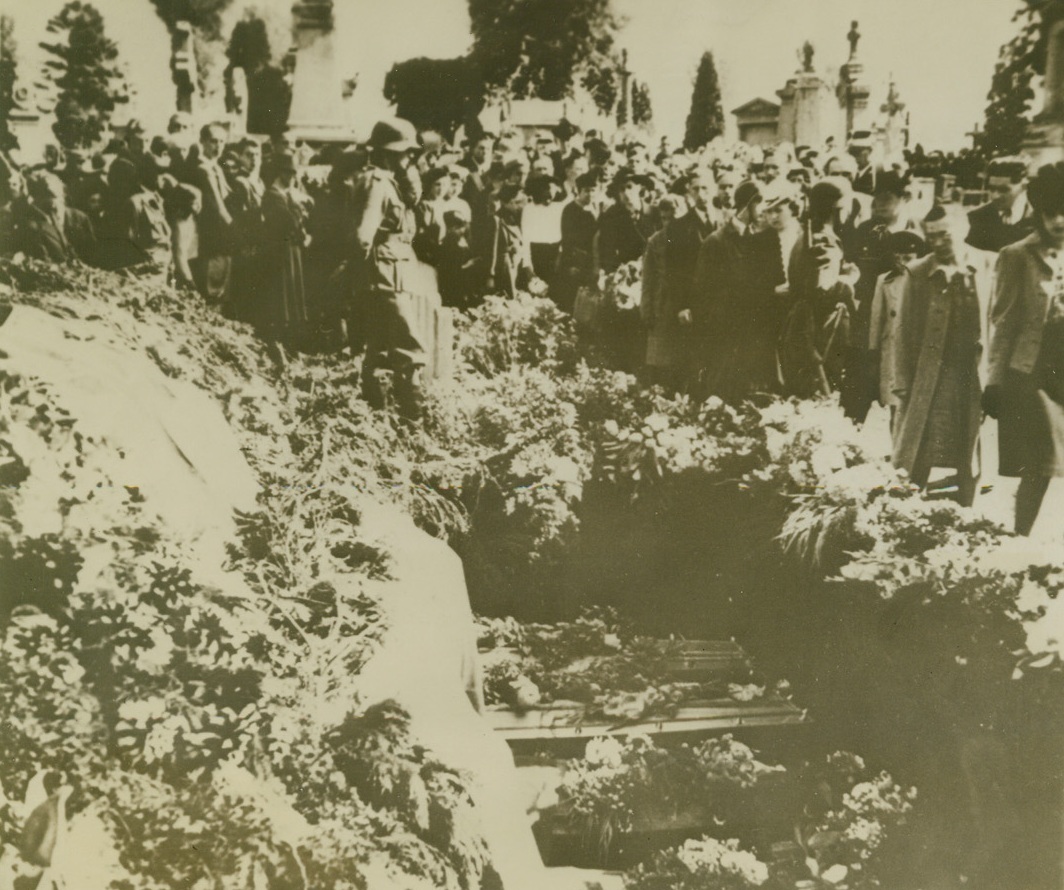
Belgians Pay Homage to British Airmen, 11/10/1942. BLAINE-LE COMTE, BELGIUM – German soldiers and guards could not prevent spontaneous demonstrations of Belgian citizens who buried RAF fighters who were shot down while raiding a Nazi-utilized Belgian railway producing center. Crowds of Belgians pass before the coffins to pay homage. Eleven German soldiers were killed and 24 others were wounded when the plane wreckage ignited a school used as Nazi military headquarters. Seven RAF fliers were buried by patriotic Belgians.Credit Line (Acme);
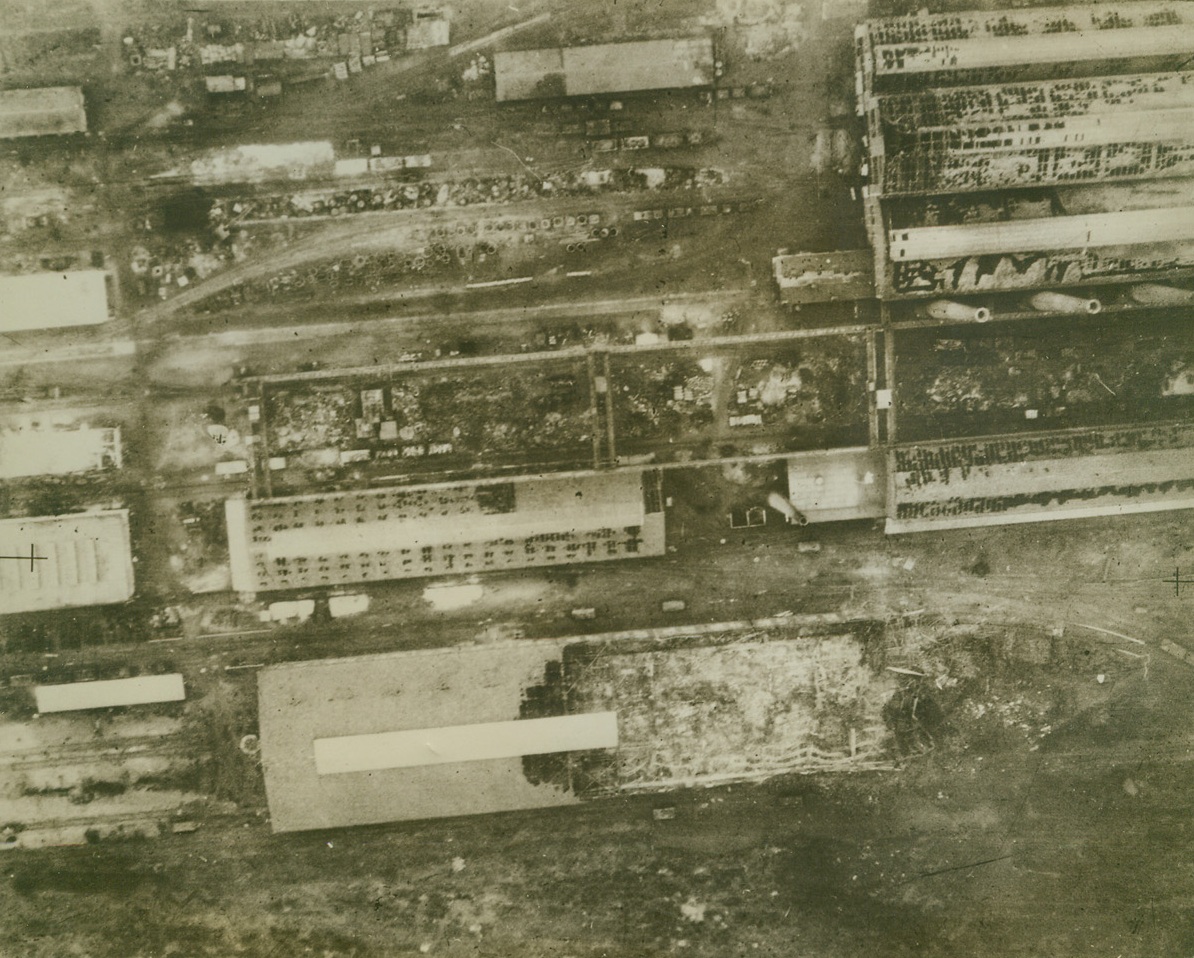
Breuil Steelworks Damaged in Krupps Raid, 11/10/1942. LE CREUSOT – The Breuil steelworks, one of three main sections of the steel-plants at Le Creusot, was blasted by the RAF on October 17. This reconnaissance photo shows the most severe damage to be: 1. Probably direct hit at the south end of steelworks, causing partial collapse of framework; 2. Severe blast damage to a shed adjoining the works; 3. Half a warehouse destroyed by a direct hit; 4. Severe blast damage to another warehouse.Credit Line (Acme);
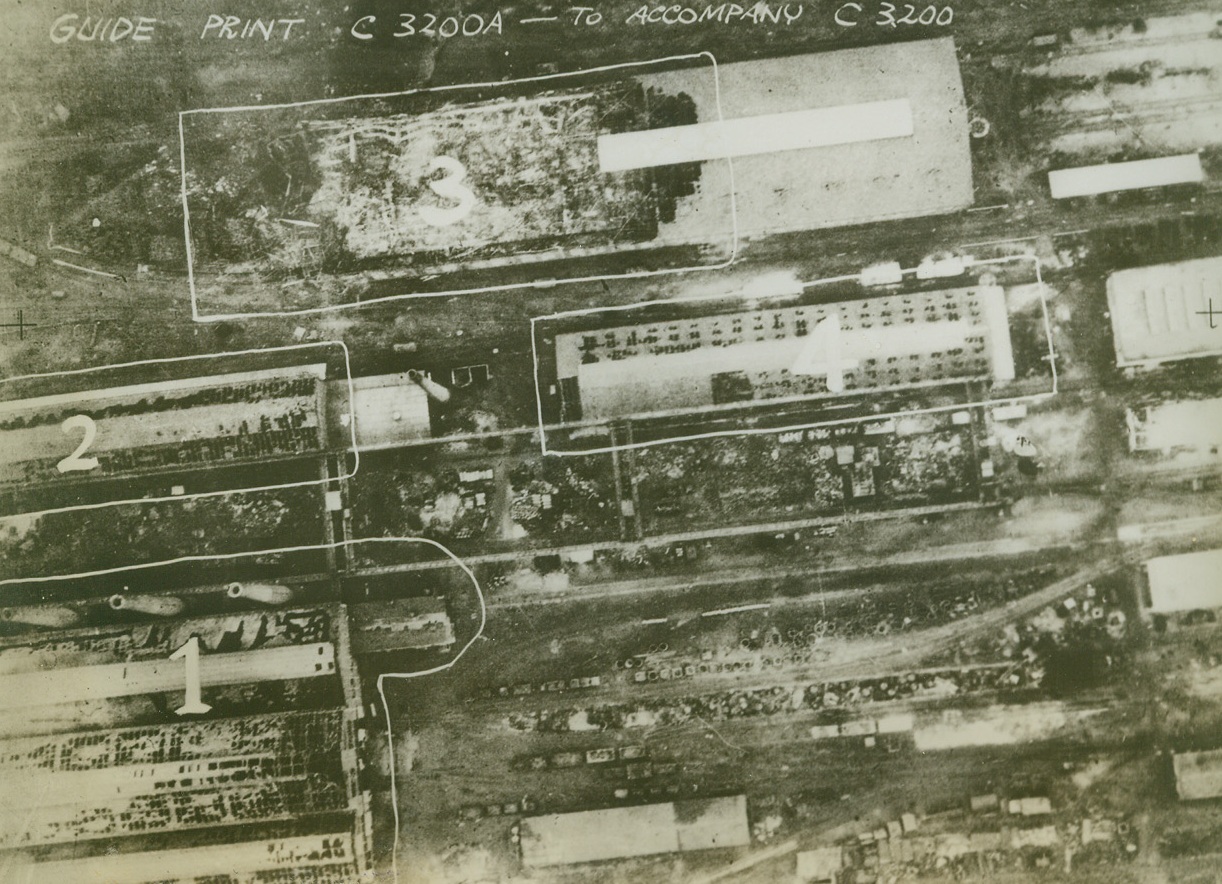
Breuil Steelworks Damaged in Krupps Raid, 11/10/1942. LE CREUSOT – Heavy damage was done to the steelworks at Le Creusot on October 17 when the three main sections of the valuable “Krupps: plant were blasted by 94 RAF Lancaster bombers. This reconnaissance photo shows the damaged sections of the Breuil steelworks – one of the three steelwork branches. A direct hit destroyed half a warehouse, another leveled the south end of the steelworks, while a severe blast damaged an adjoining shed and another warehouse.Credit Line (Acme);
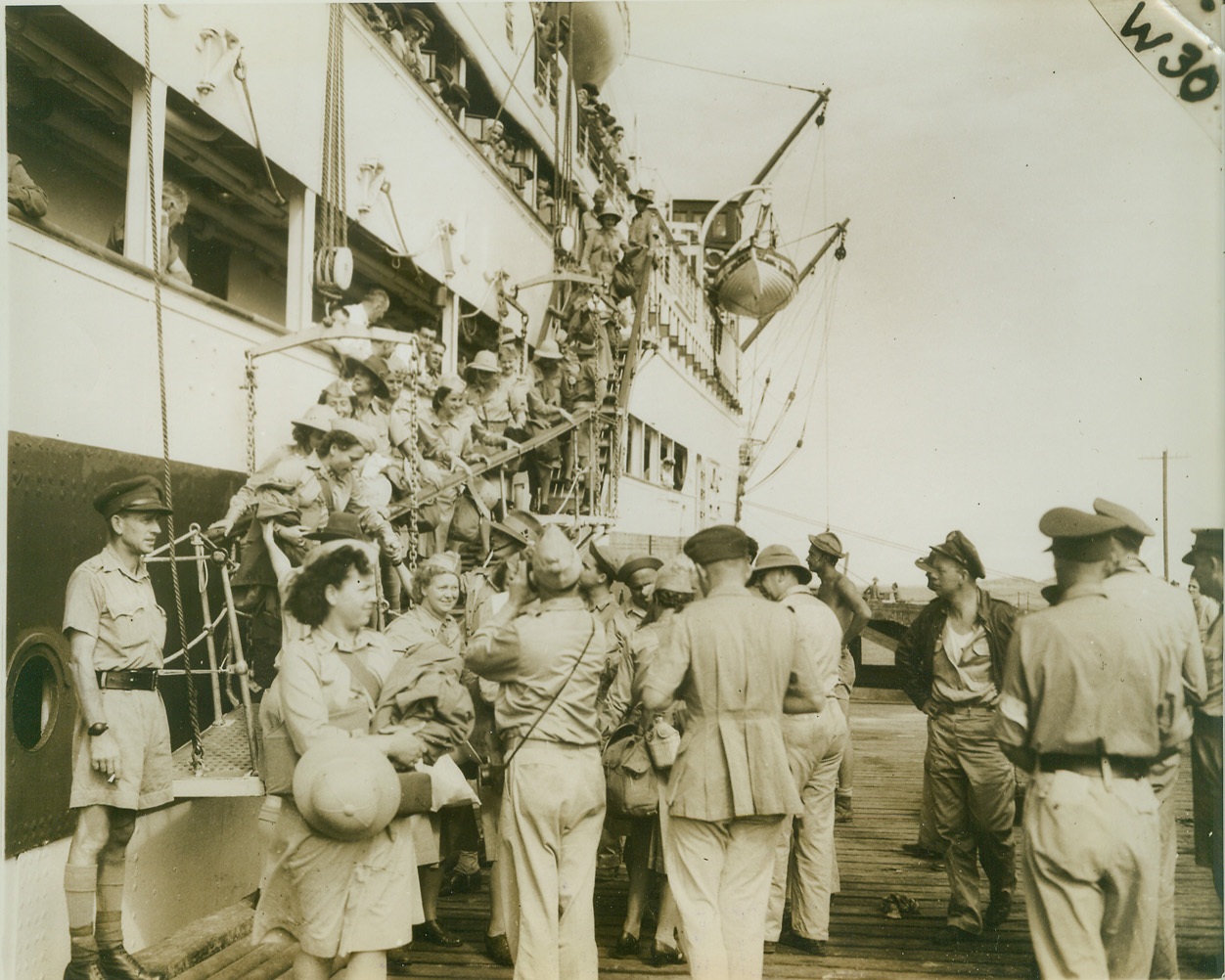
U.S. ARMY NURSES ARRIVE IN NEW GUINEA, 11/12/1942. NEW GUINEA – Eighteen U.S. Army nurses, the first white women to set foot in New Guinea since March 1942, arrive at an Allied advance base in the South Pacific stronghold. No other American nurses have been sent to the unnamed base, close to the fighting areas. Credit: ACME;
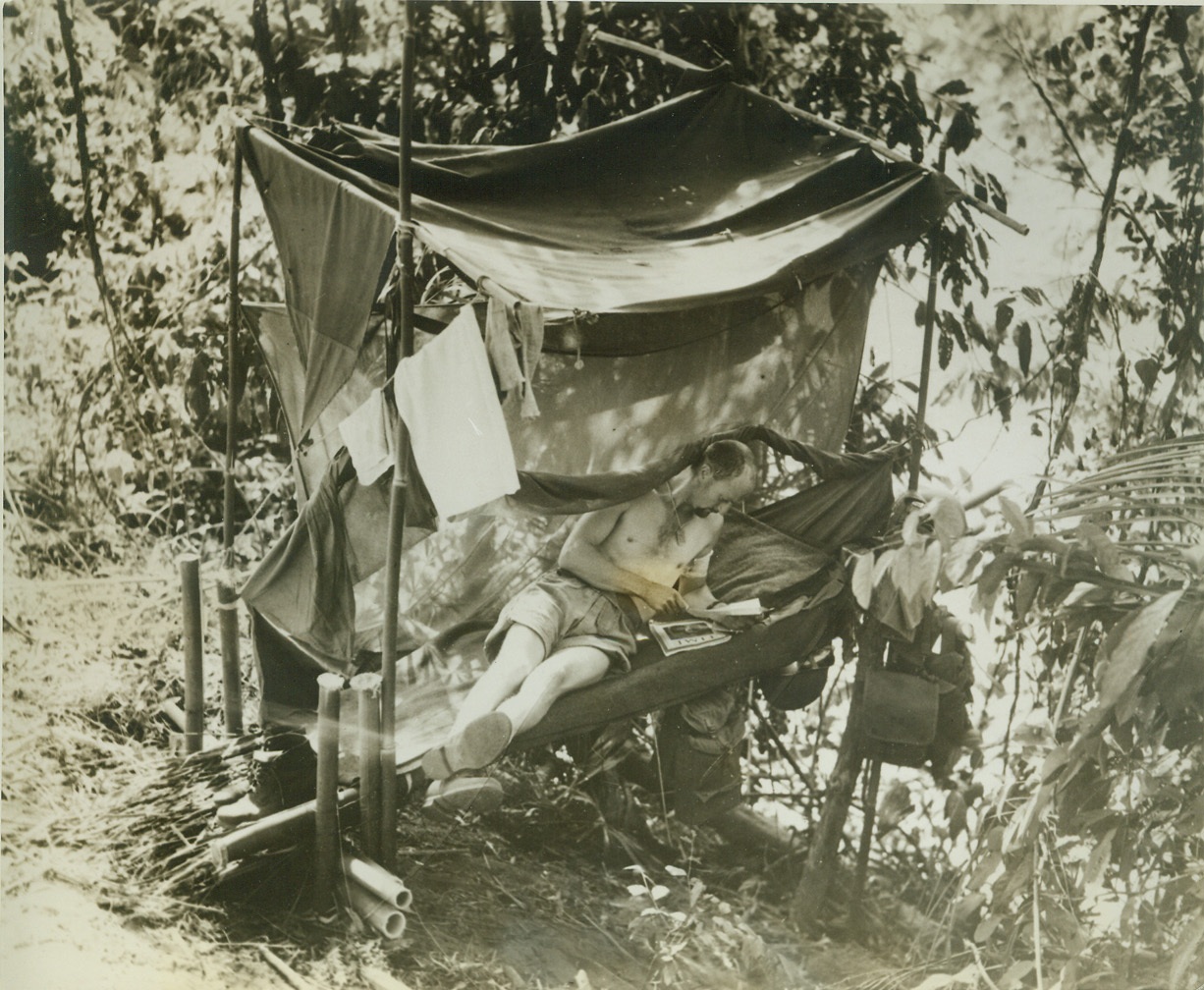
All the Comforts of Home, 11/12/1942. NEW GUINEA -- Americans love their comfort, and wherever they go they're bound to make themselves as comfortable as possible. Corp. Verl Parmee, a member of U.S. Infantry troops in New Guinea, relaxes and reads a letter from home on his unique bed, which he fashioned with bamboo poles. Credit: (ACME);
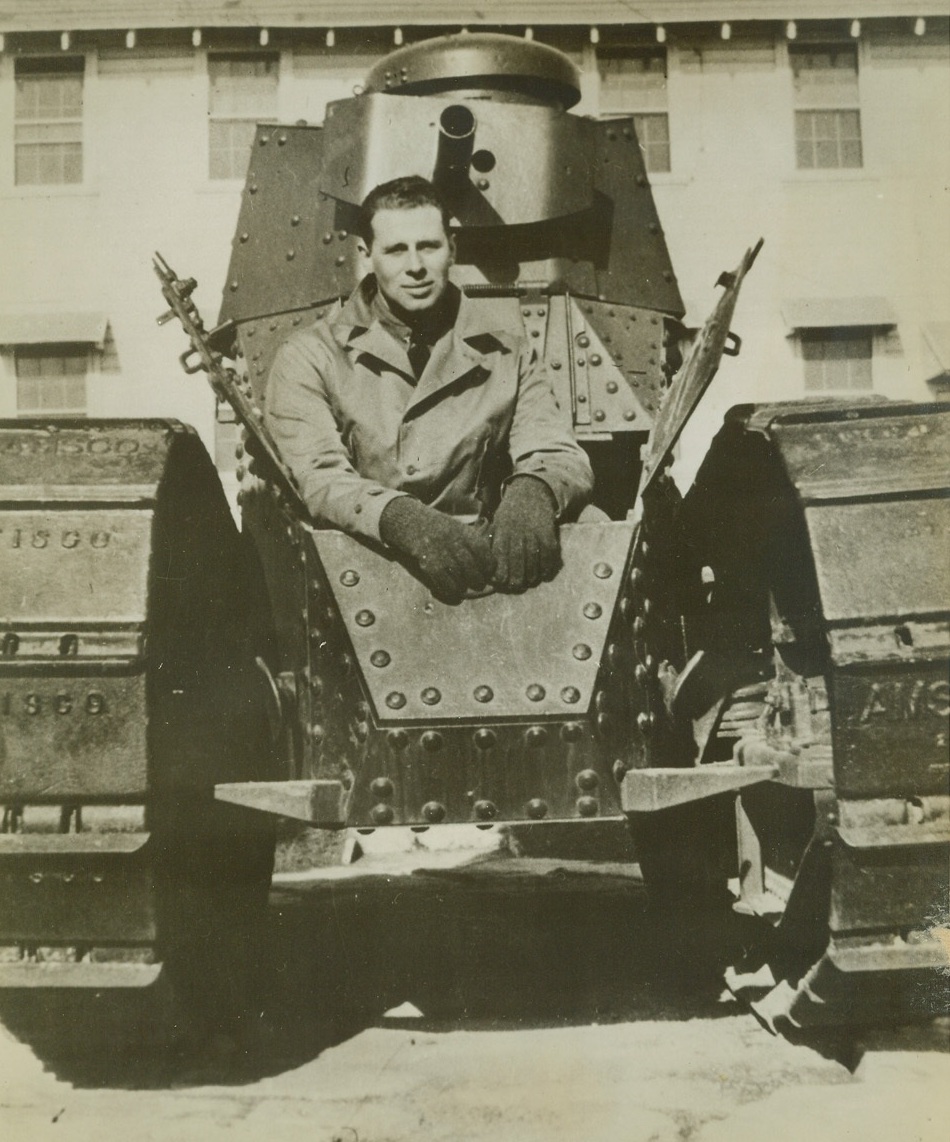
One Man City-Buster, 11/13/1942. ORAN -- A one-man terror, Corp. Bernard J. Kessel, who manned the 75 on the American medium tank that conducted its own successful offensive on Oran, said, "I guess that picture of the girl friend (Rita Weinberg), mounted next to my 75 is a lucky charm." Separated from their unit, the tank penetrated the city all alone, ramming and destroying three 75 mm. guns and 50 motor vehicles and emerging with its armor plate marked up by decked with the French guns. Credit: (ACME); 1
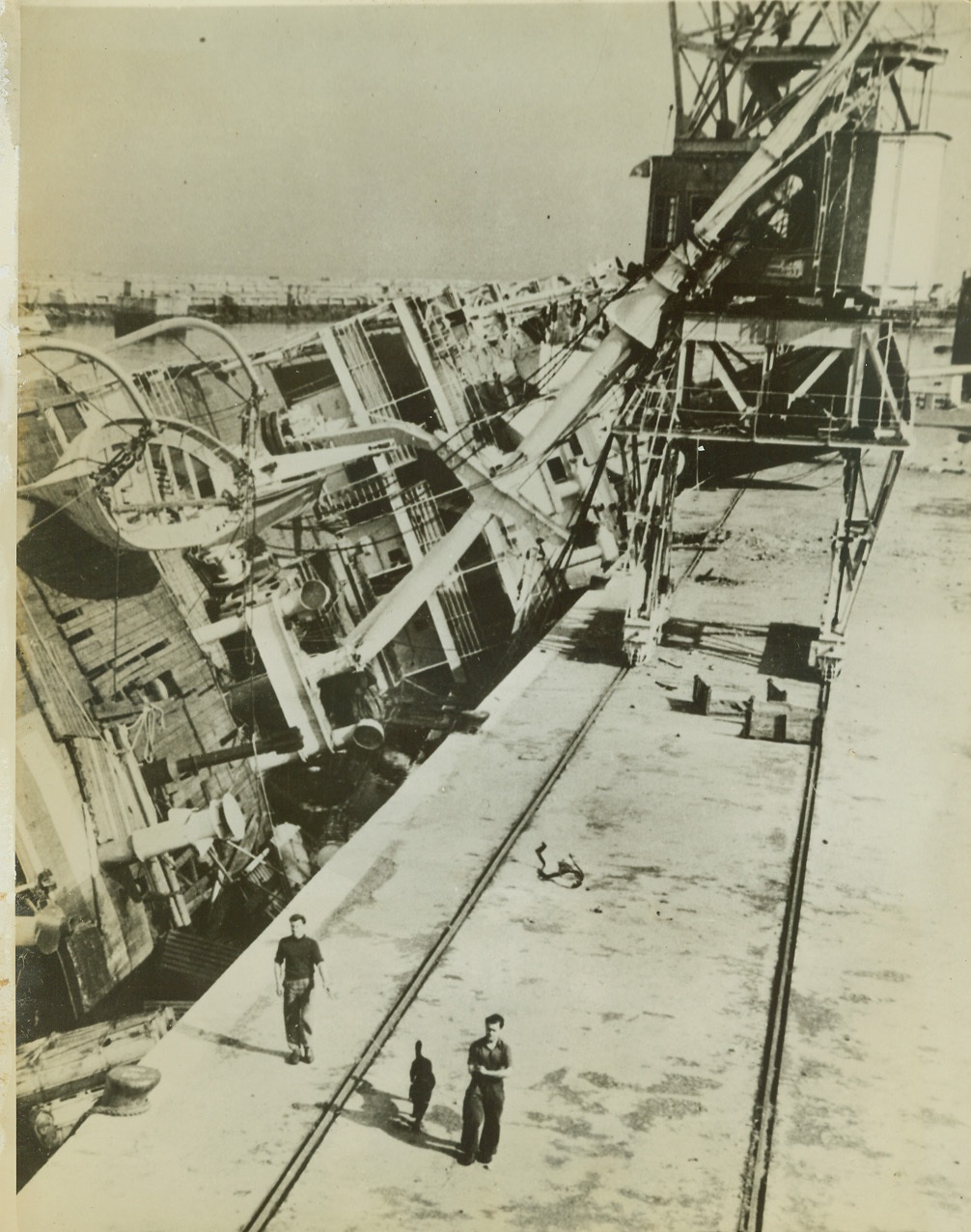
ON HER SIDE, 11/25/1942. MOROCCO – A capsized merchantman careens against the quay in Casablanca harbor after defenders of the seaport were defeated by American forces. Latest dispatches from the North American front indicate progress in the British drive on Bizerte and Tunis. Credit: ACME;
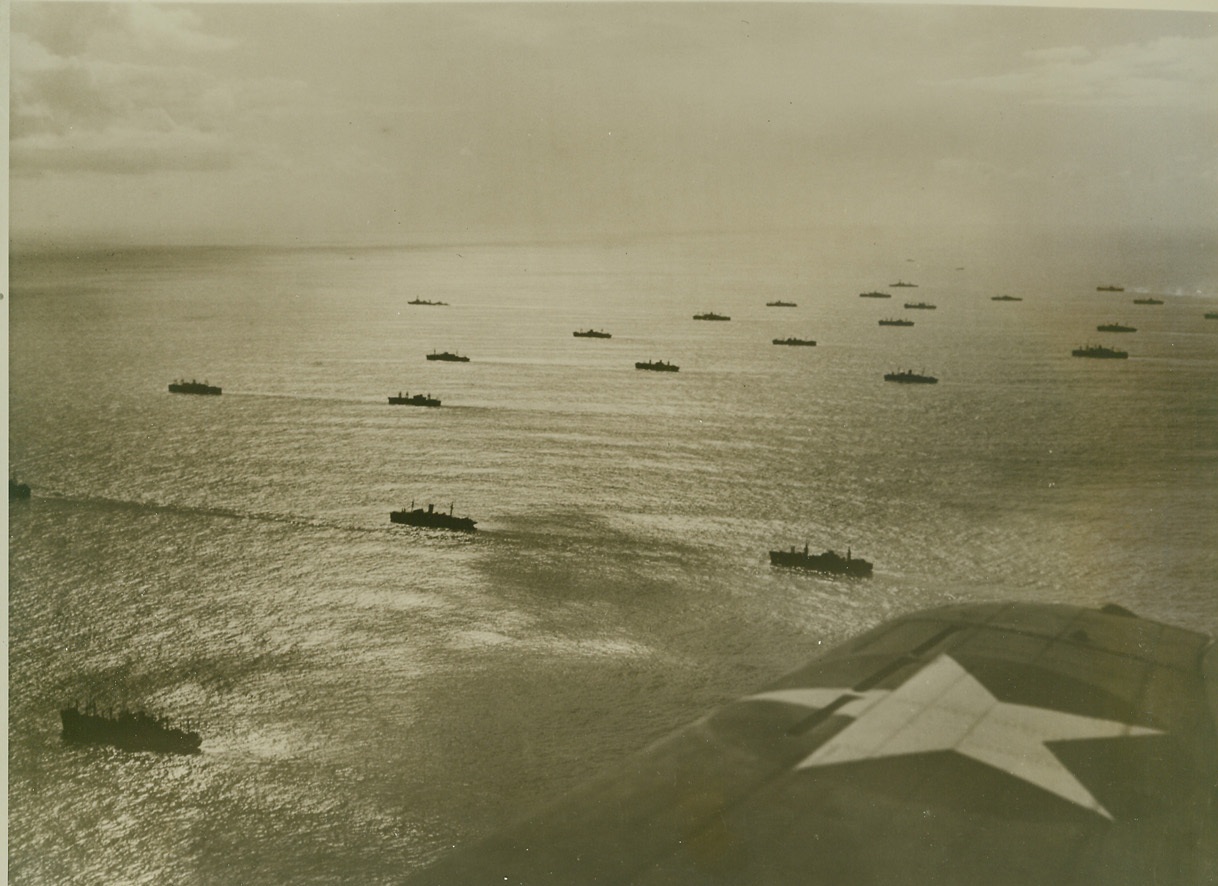
DESTINED FOR AFRICA, 11/26/1942. Steaming in perfect formation, a huge United Nations convoy plows through the Atlantic Ocean, bound for Africa, where troops were landed in French possessions the first part of November. The convoy was well escorted by sea and air, as shown by this aerial photo of the remarkable sea expedition, which reached all ports virtually unscathed. Credit: ACME official U.S. Navy photo;
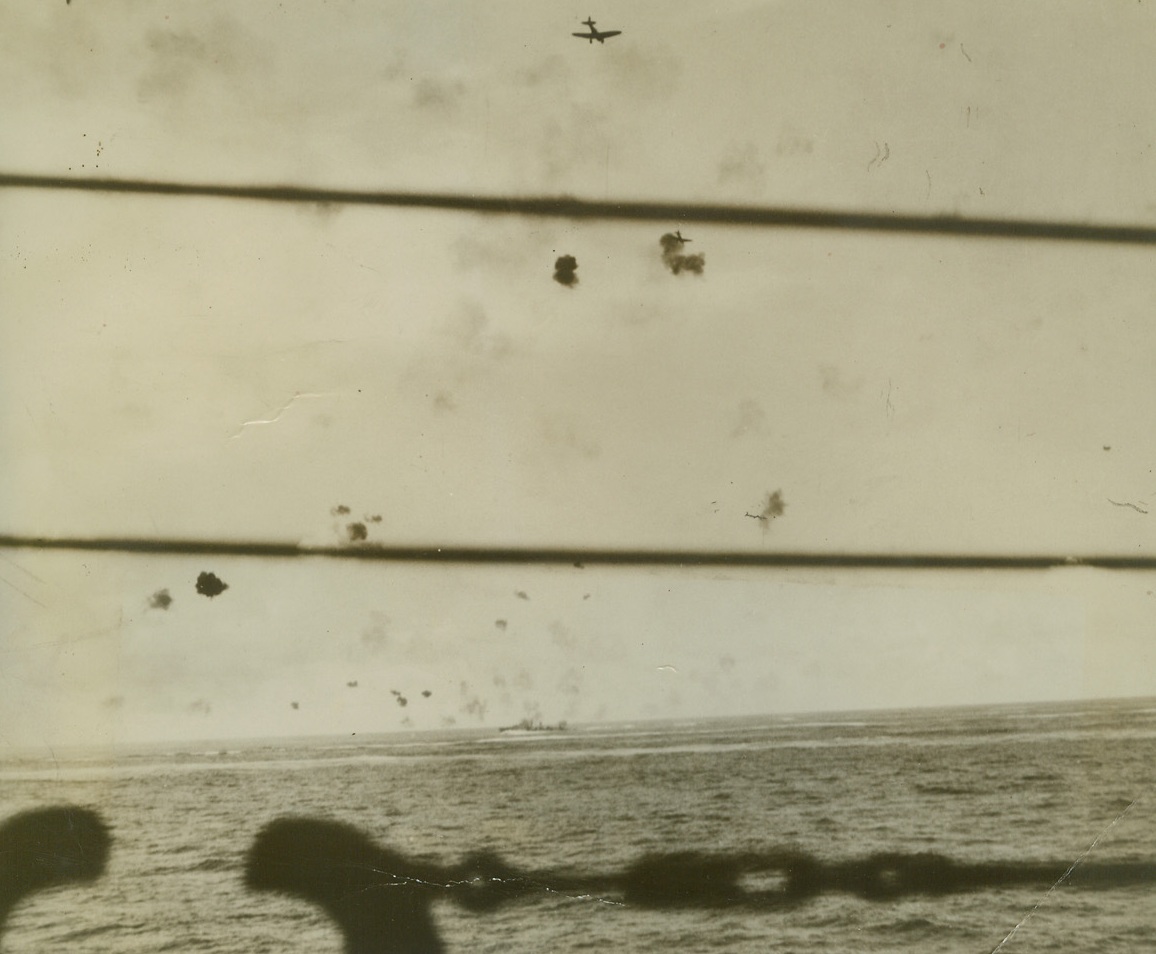
JAP BOMBERS IN ACTION, 11/30/1942. The camera caught these two Jap bombers as they passed over a U.S. carrier in the first phase of a triple bombing and torpedo attack on the carrier off Santa Cruz Islands in the South Pacific on Oct. 26th. Some 80 enemy planes attacked the carrier on that morning. Credit (Official US Navy Photo from ACME);
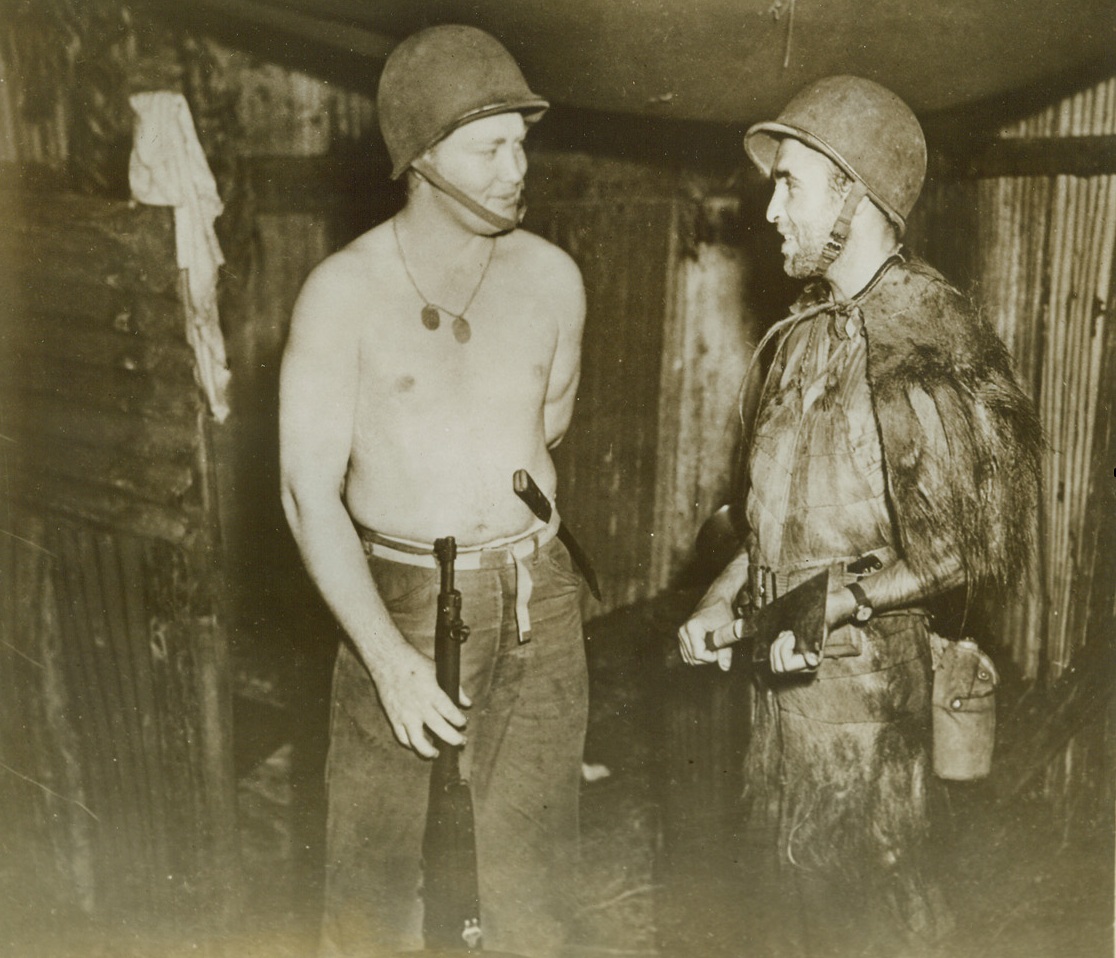
Marine Models Jap Sniper’s Uniform, 11/4/1942. In this photo just released in Washington, one Marine, (right), models the uniform made of the skin of a long-haired animal, which is worn by Jap snipers. Picture was taken on “some battlefront.” Credit: U.S. Marine Corps photo from ACME;
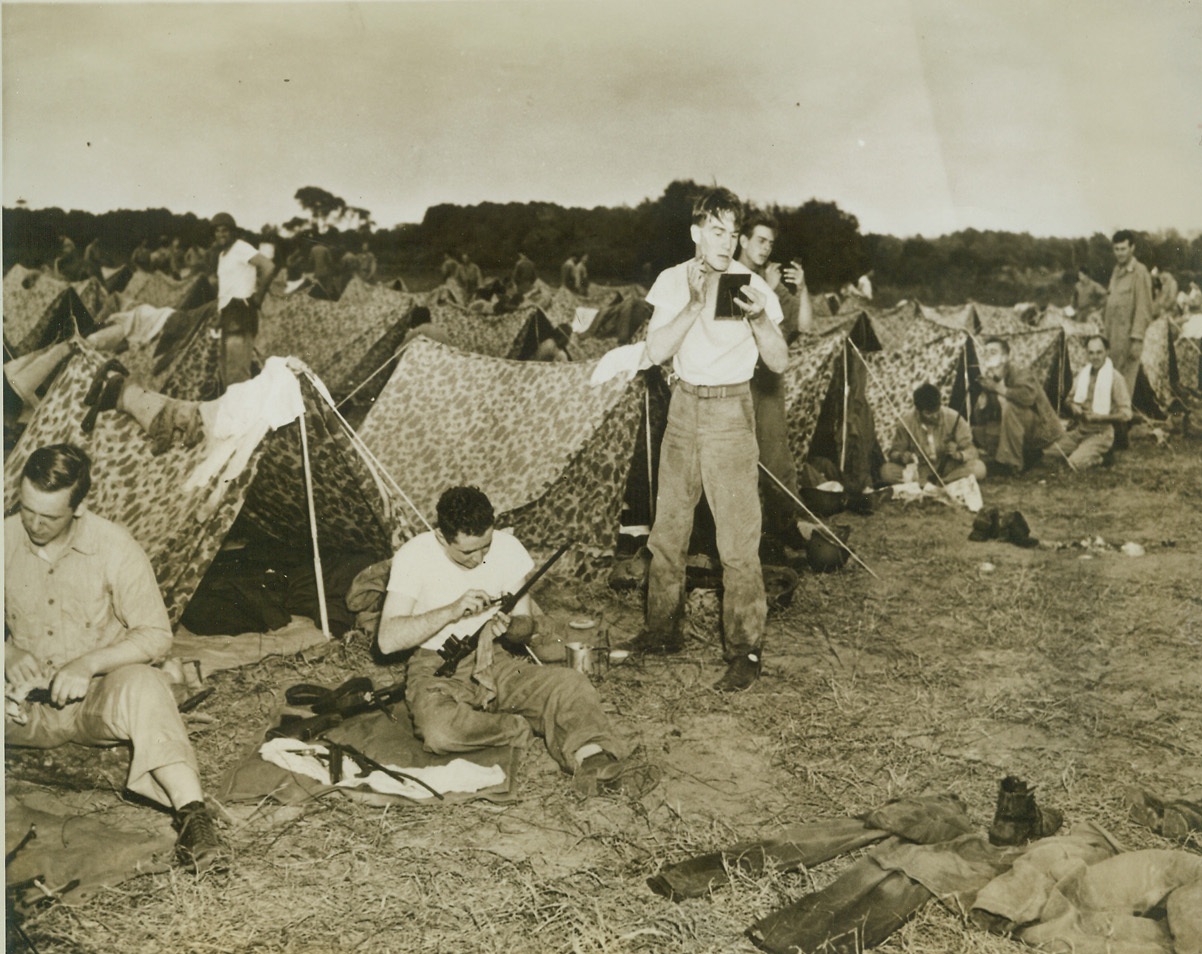
Leisure Time, 11/5/1942. NEW RIVER, N.C. - Even their leisure time must be devoted to countless necessary tasks. In bivouac after landing operations, these Marines sit before their camouflaged pup tents and clean their rifles to keep them in working order while their buddies shave. This is part of the training the men receive at the U.S. Marine Base at New River. Credit: (ACME);
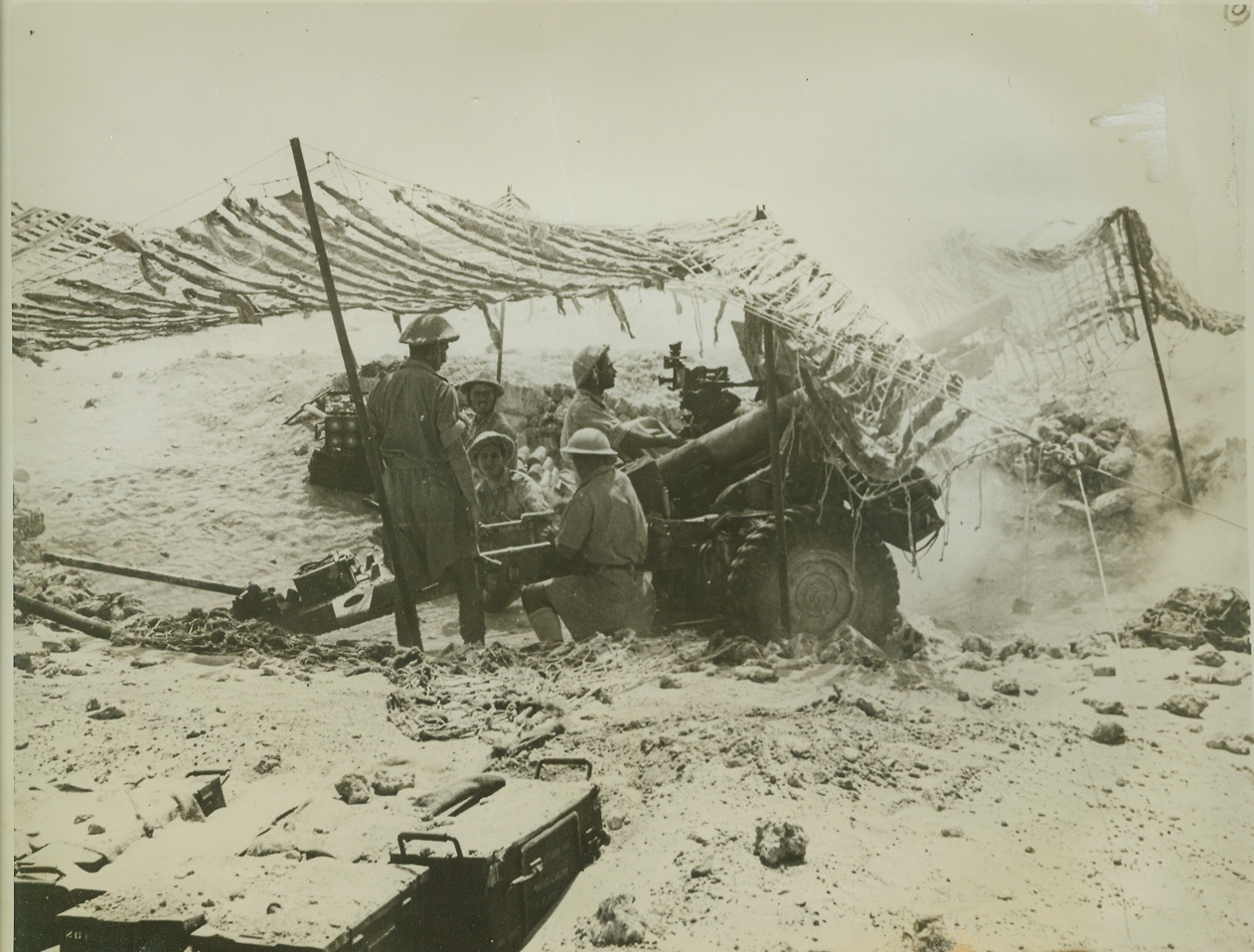
DESERT DEATH, 11/6/1942. WESTERN DESERT – Under a netting that camouflages the heavy cannon from enemy aircraft, a Greek Army crew fires a shell into an enemy aircraft position in the Western Desert. Latest reports indicate the Axis forces are being crushed by the fury of the United Nations dive to push Rommel’s army out of Africa. Credit: ACME;
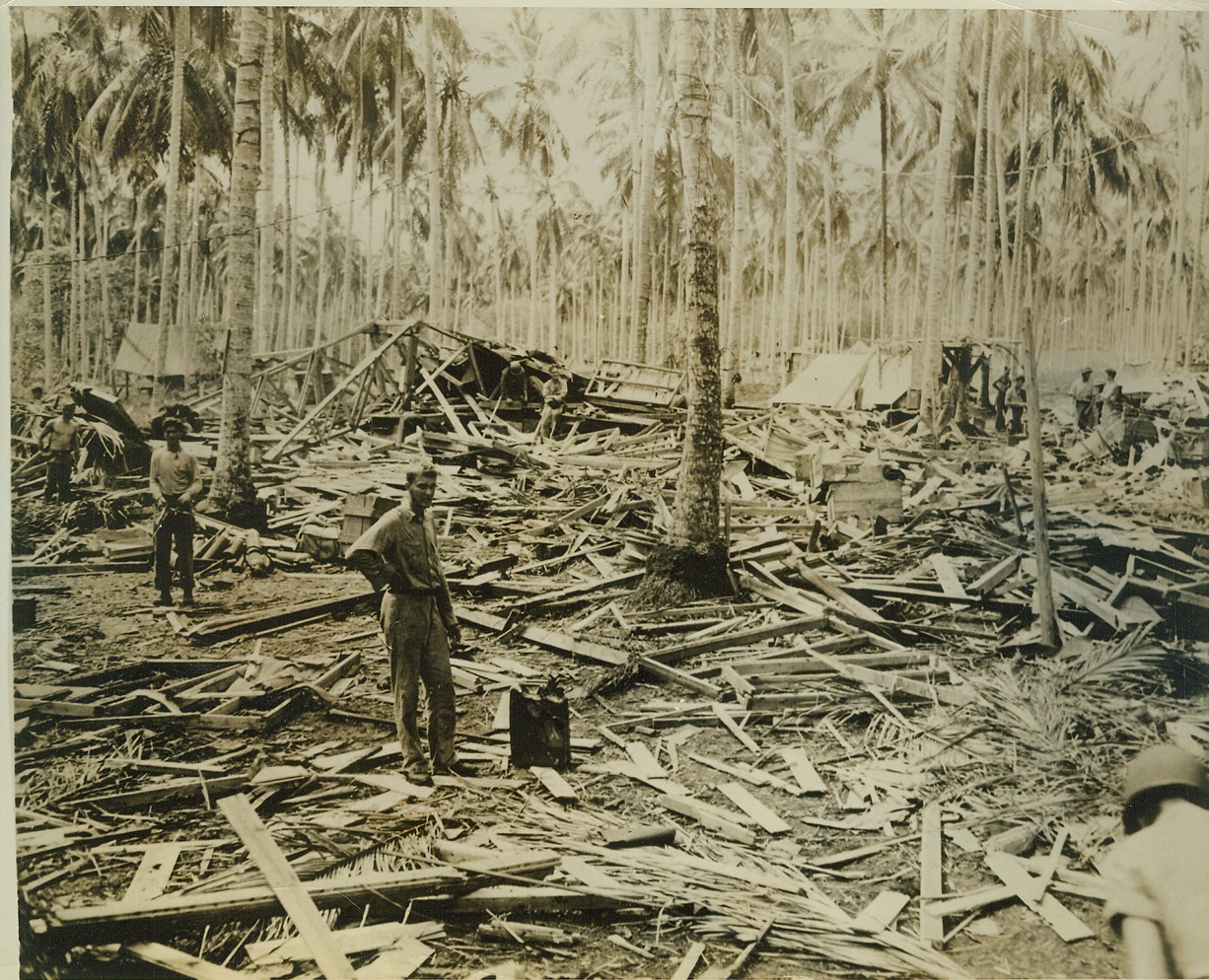
Signing Off, 11/7/1942. Guadalcanal – A direct hit by a Japanese aerial bomb turned what was once a U.S. radio receiving station into this mass of debris. It was destroyed during one of the many air raids which the Japs have launched against American forces on Guadalcanal. Credit: (A US Marine Corps Photo from ACME);
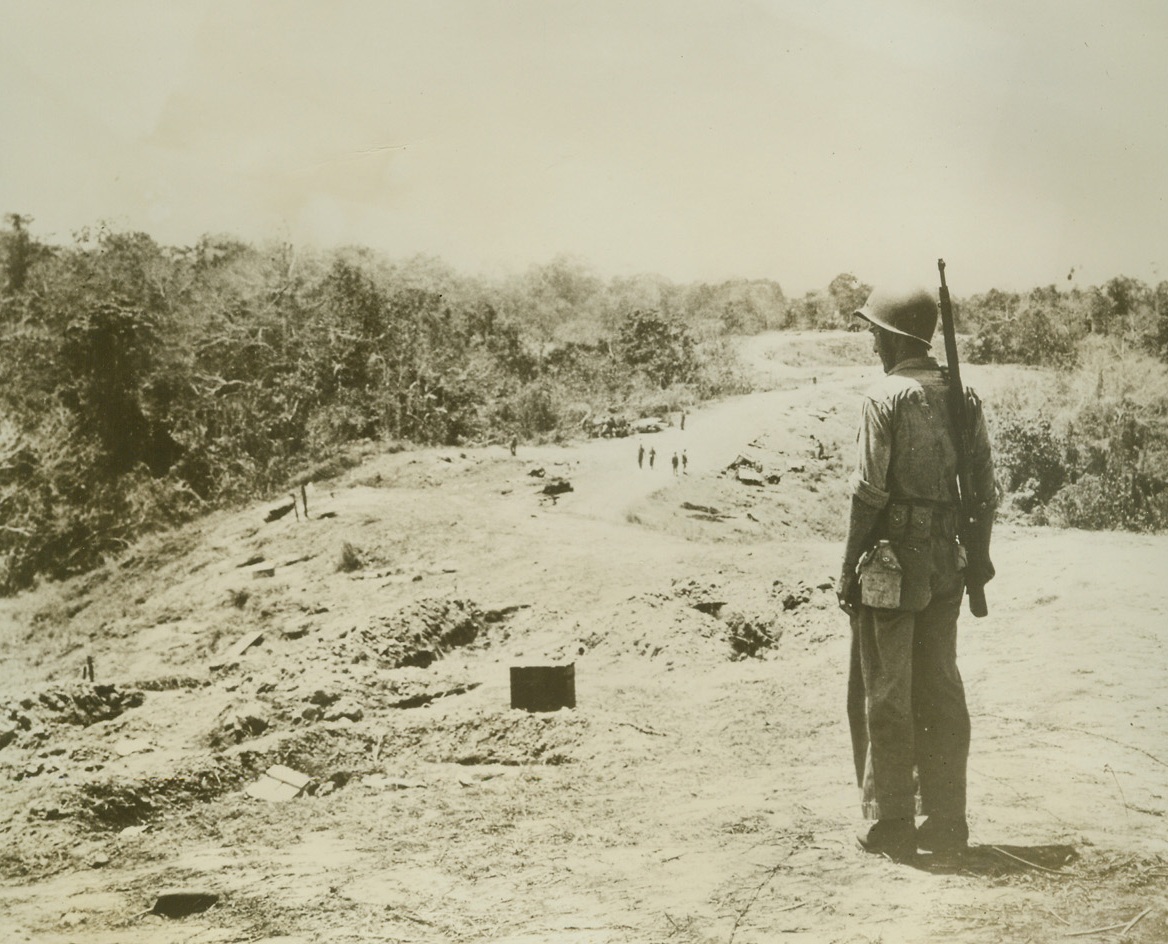
600 Japs Died Here, 11/7/1942. Guadalcanal, S.I. – Six hundred Japs died as U.S. Marine raider battalions, entrenched on this ridge, turned back thrust after thrust by the enemy. Heavy artillery was used to defend the ridge, which protects Guadalcanal’s all-important airport, Henderson Field.Credit Line (U.S. Marine Corps photo from ACME);
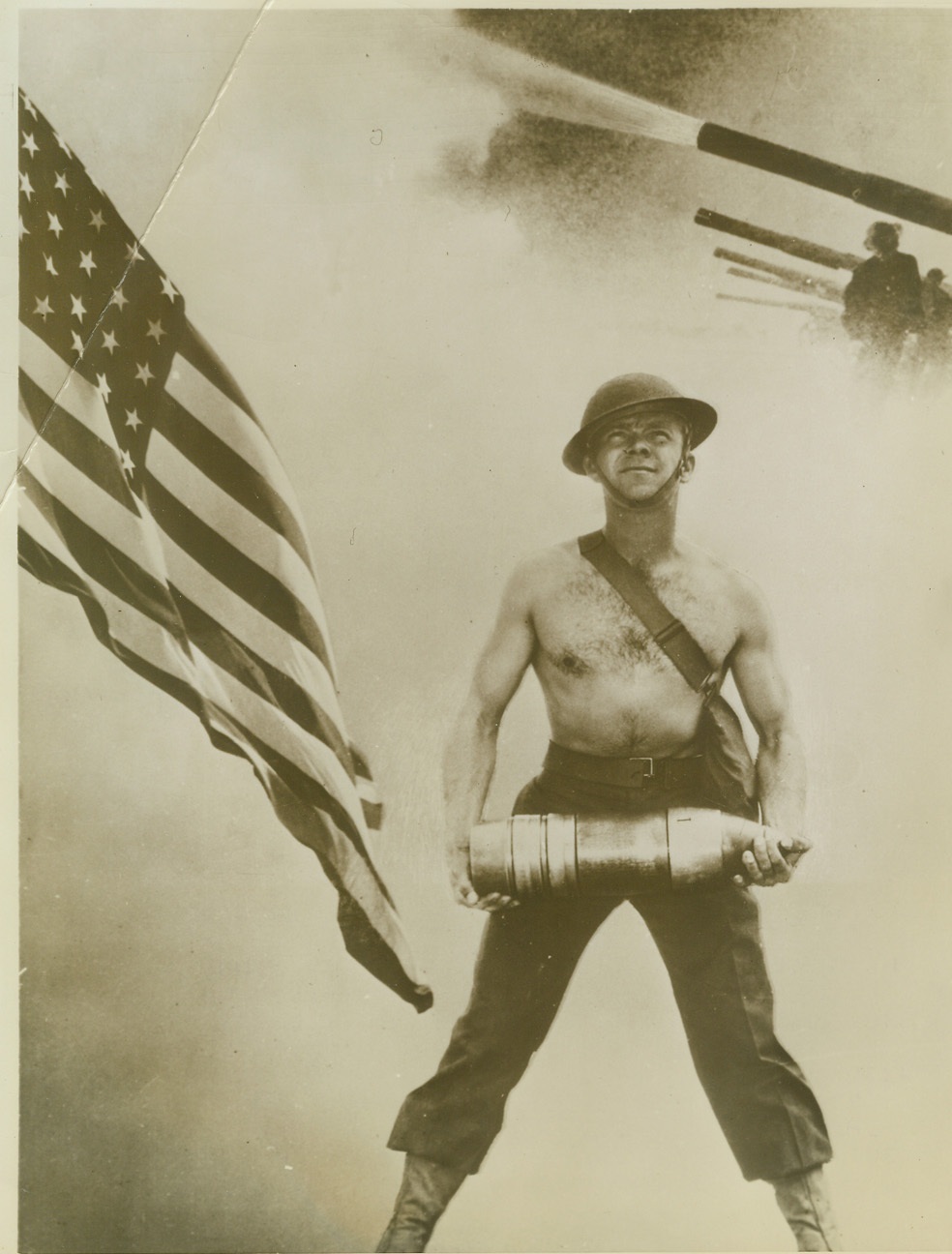
“And We’ll all be Free”, 11/6/1942. Camp Callan, Calif – A fighting Marine beside the Stars and Stripes and ready to “pass the ammunition” symbolizes observance of United States first wartime Armistice Day, next week. Sun-browned and tough-muscled, the Camp Callan soldier is joined by thousands of other fighting leathernecks battling for all the first Armistice results’ failed to accomplish. Credit: (ACME U.S. Army Photo);
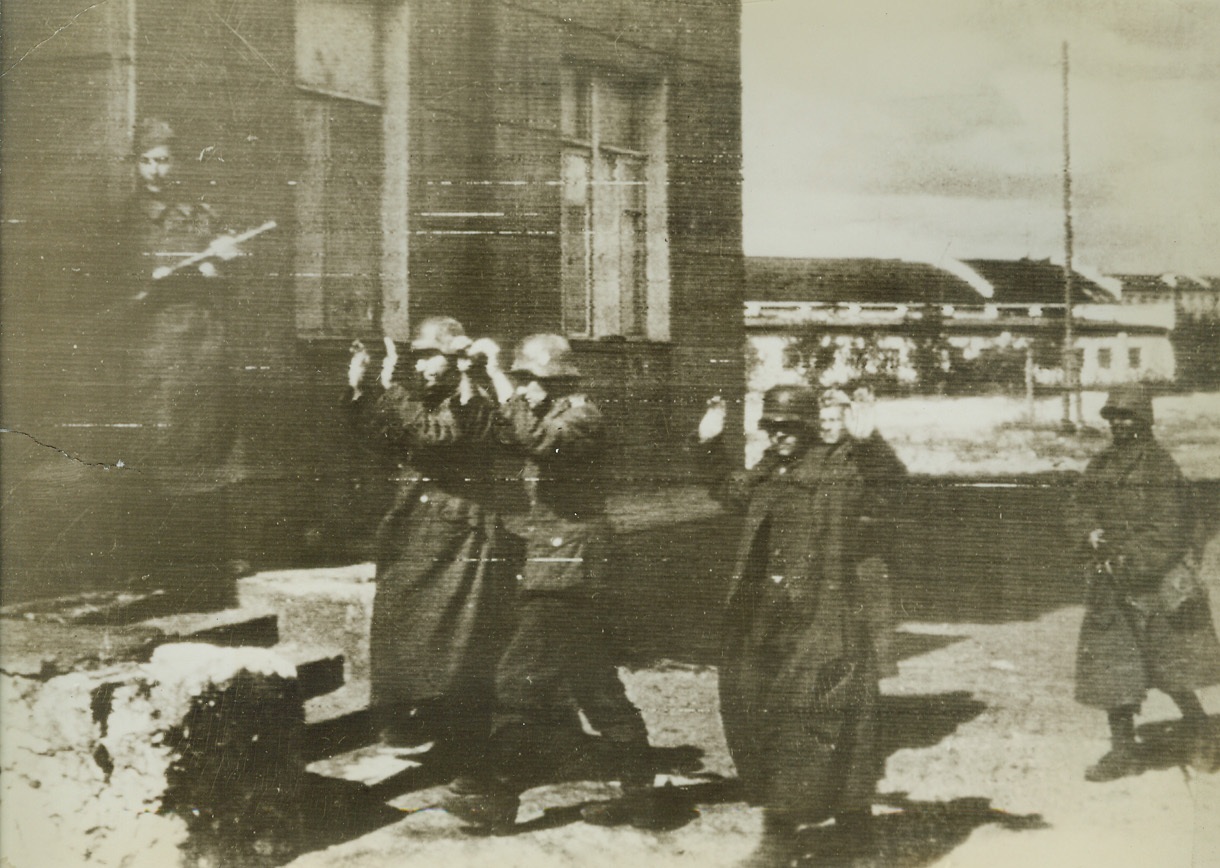
Nazi Prisoners at Voronezh, 11/15/1942. VORONEZH, U.S.S.R—Red Army men lead some of their many Nazi prisoners into captivity at Voronezh after a battle in which the city stood firm against heavy German assault. Photo was radioed to London from Voronezh. Latest dispatches from Moscow announce that the Reds are also holding their own in Stalingrad and gaining ground around Nalchik in the Caucasus.Credit: ACME.;
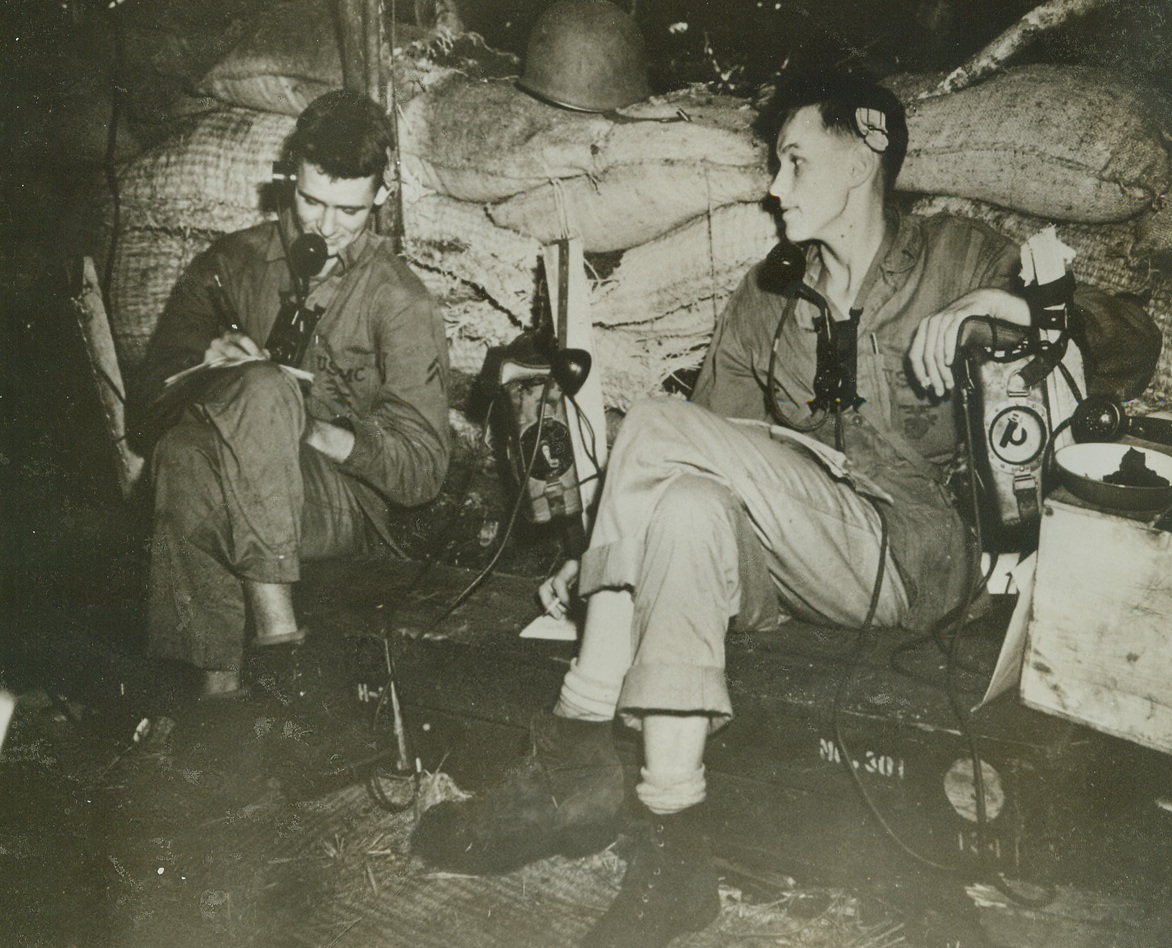
Guadalcanal Hot Spot, 11/4/1942. Washington, D.C. – Vital messages are relayed through this communications dugout located in a fighting zone, “somewhere in Guadalcanal.” These Marines receive and transmit firing date, dispatches and other information needed by U.S. forces in their fight against the Japs. Reports from the Solomons today, when this photo was released in Washington, indicate that Americans face heavy fighting by newly reinforced Nipponese troops on three sides of them.Credit Line (U.S. Marine Corps photo from ACME;
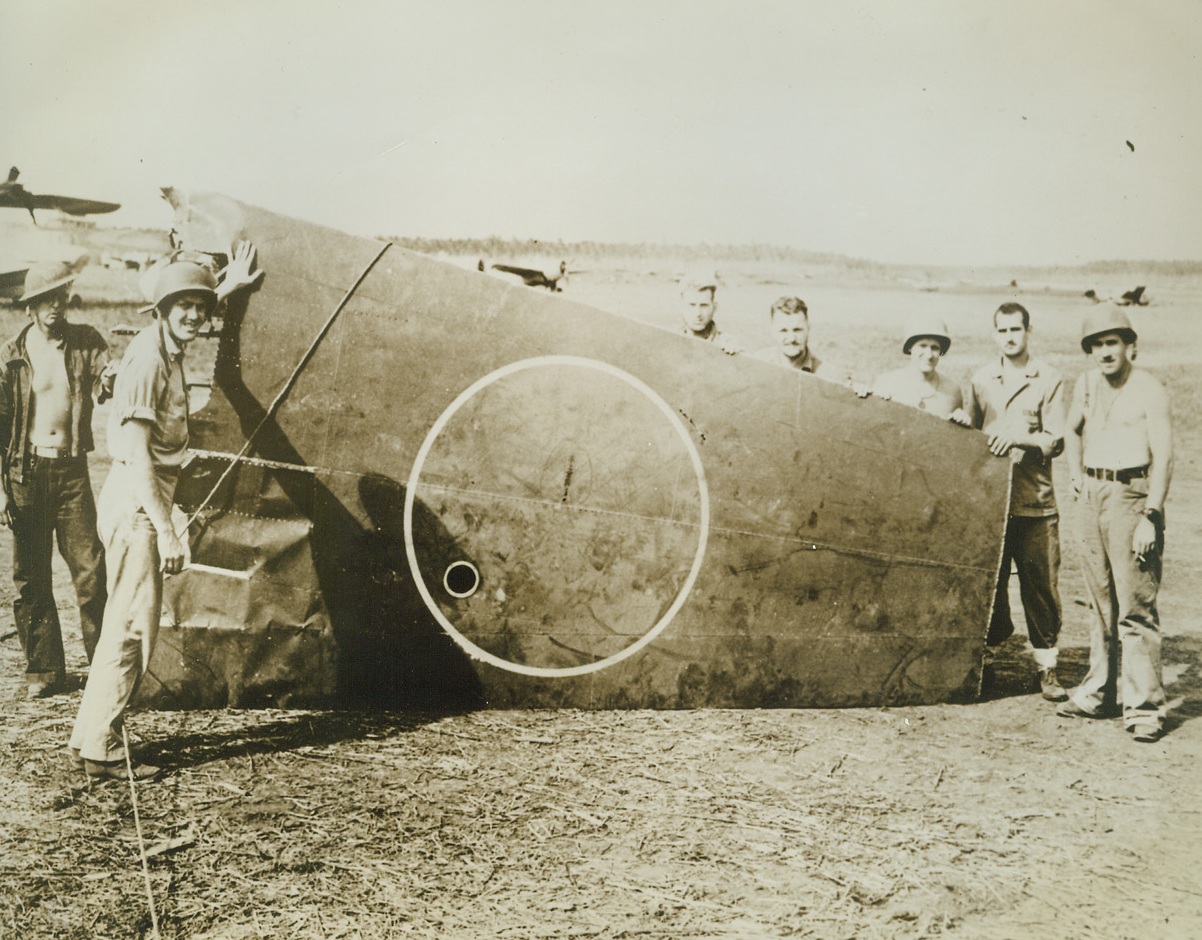
A Bit of Unrising Sun, 11/6/1942. Guadalcanal – Bits of a Jap bomber rained down on Marine-held Guadalcanal when a Leatherneck anti-aircraft shell touched off its ammunition load at 20,000 feet. The dented wing-section was the largest single piece remaining of the Jap sky-raider. Marines on besieged Henderson field, hold up their trophy. Credit (ACME Official U.S. Marine Corps photo);
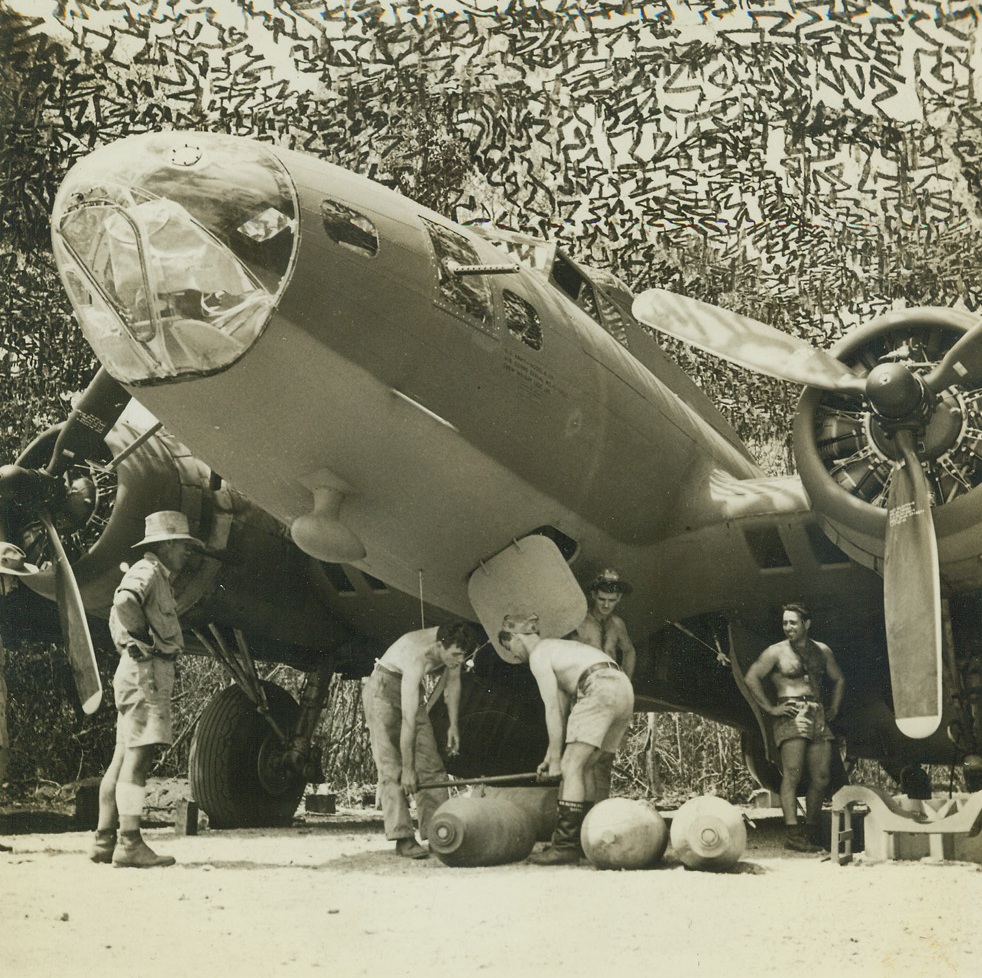
Packing the Eggs, 11/1/1942. Port Moresby – American soldiers load quarter-ton bombs into a B-17 bomber upon its return from a mission. A zig-zag camouflage net hides the plane from the air. Credit line (ACME);
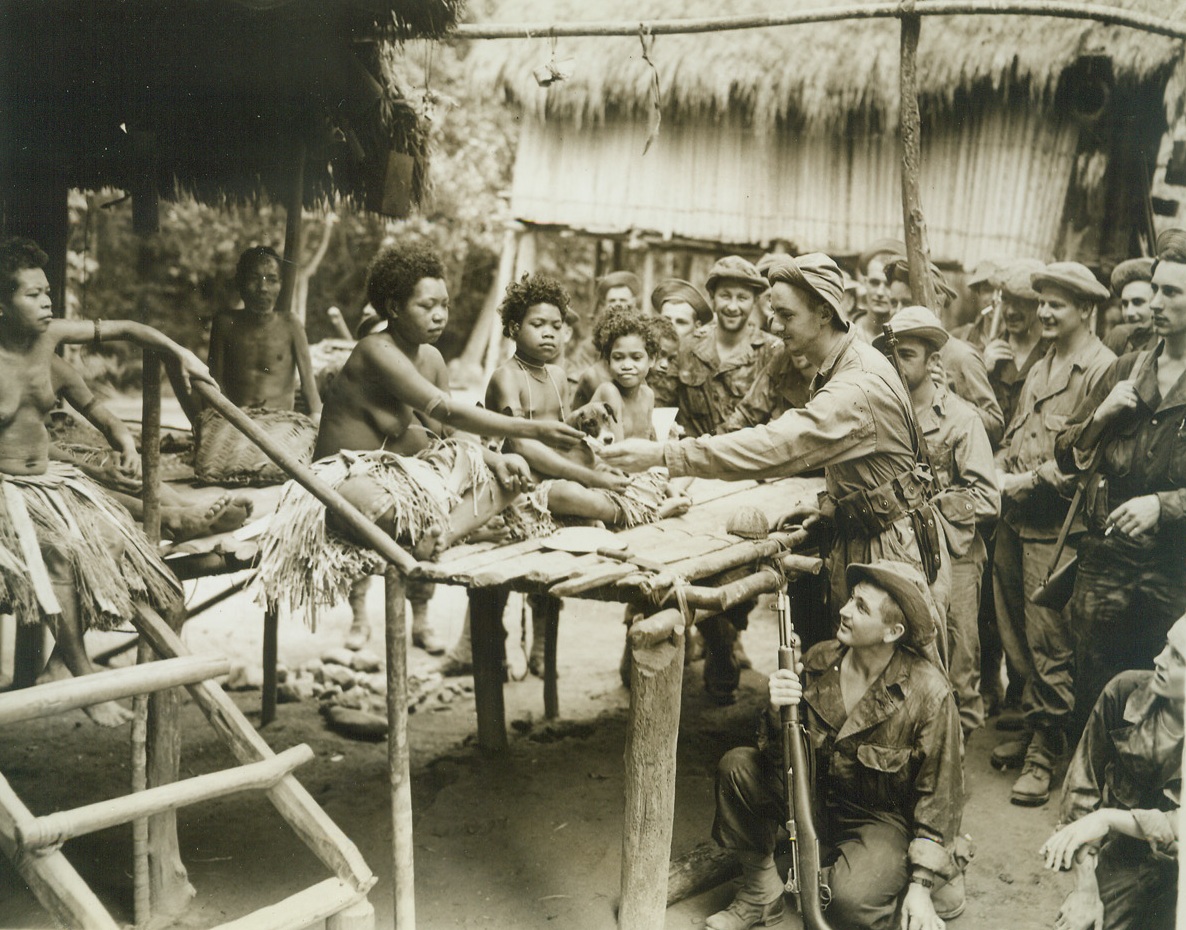
Billet Doux?, 11/13/1942. New Guinea – U.S. soldiers crowd close to a jungle hut where kinky-haired native belles line up on the front porch to inspect their khaki-clad visitors, in New Guinea. Credit line (ACME);
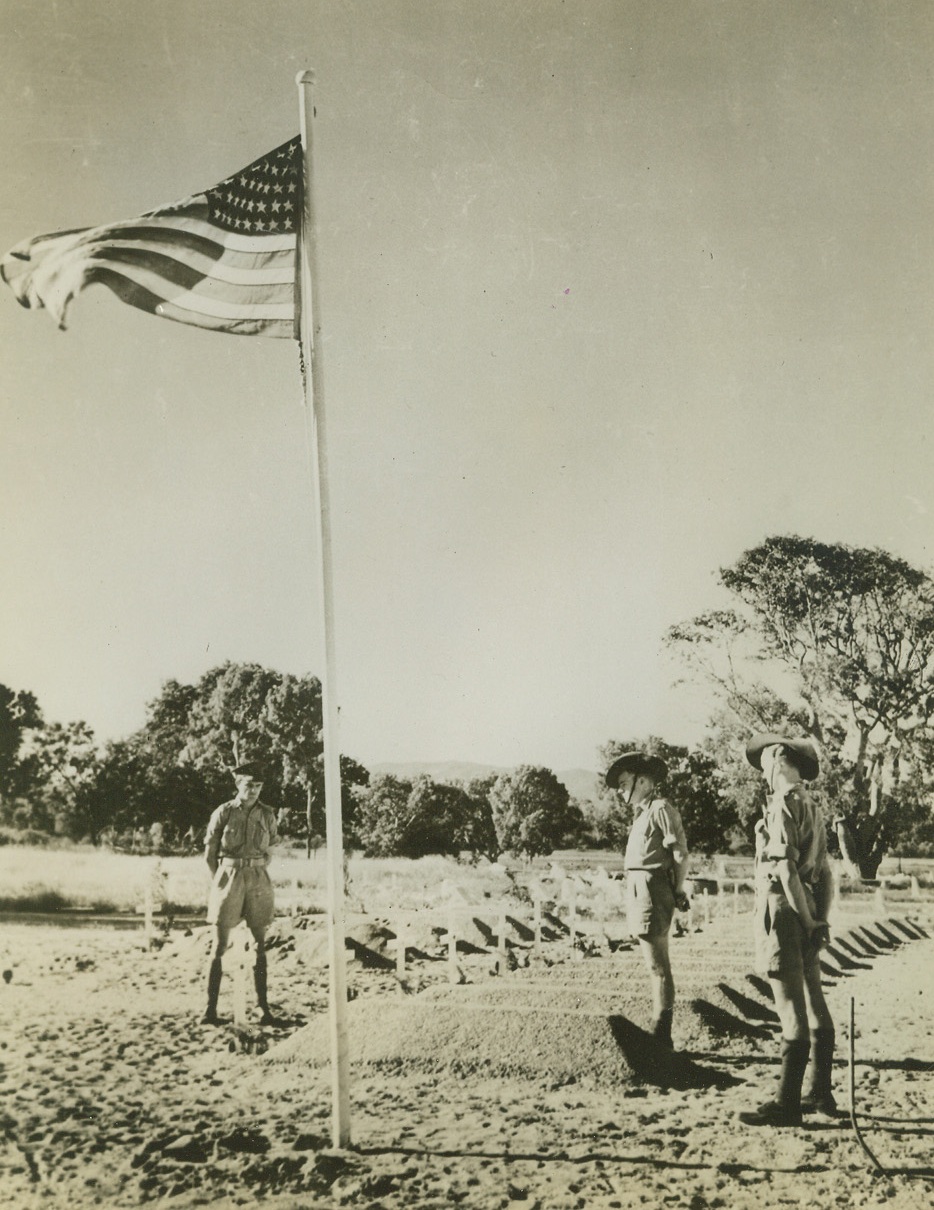
American Pilots Buried in Australia, 11/13/1942. Townsville, Australia – The stars and stripes wave above the American section of the military cemetery at Townsville, Australia, a soldier colony. The graves are mostly of U.S. airmen, killed in action, and are cared for by Australian soldiers, three of whom are shown. Credit line (ACME);
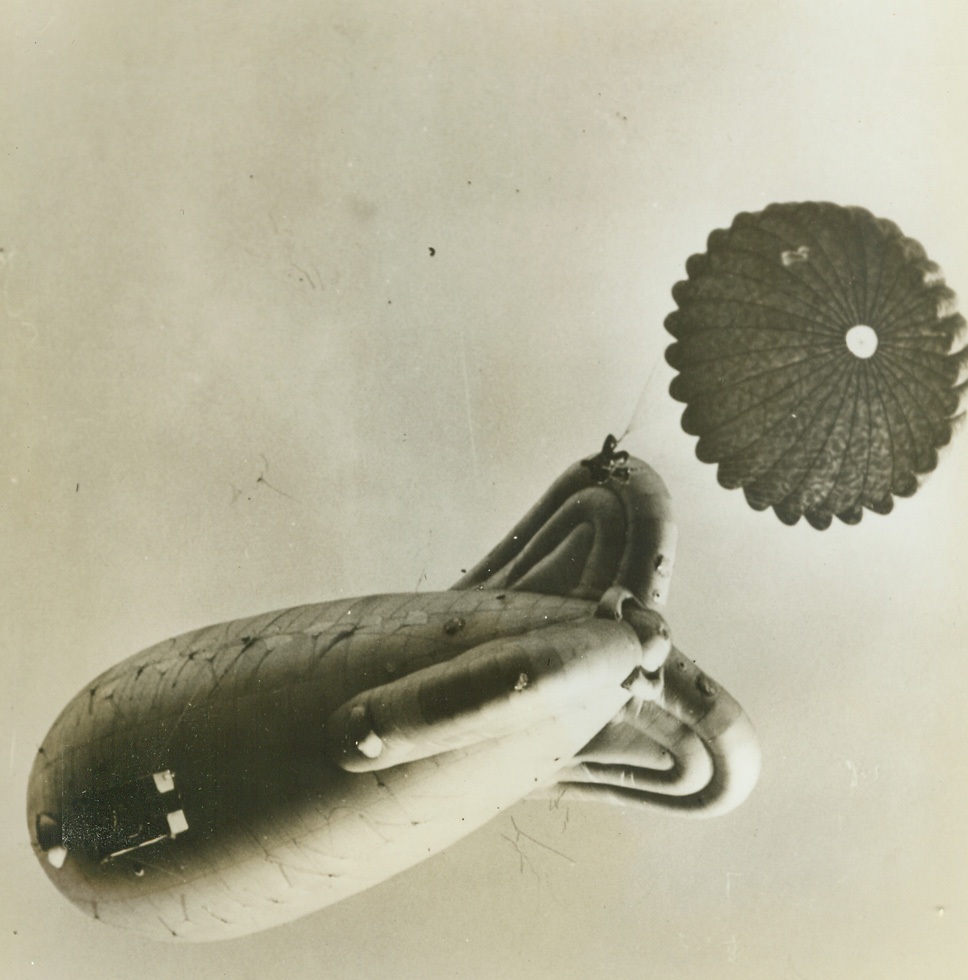
No Title. 11/3/1942. It’s this Paratrooper’s first drop, and it is a thrill to clear the tail of the static balloon that released him. Airborne troops in training don’t go from ground work to planes. Their first jumping-off place in the clouds is one of these sky fish. Credit: ACME;
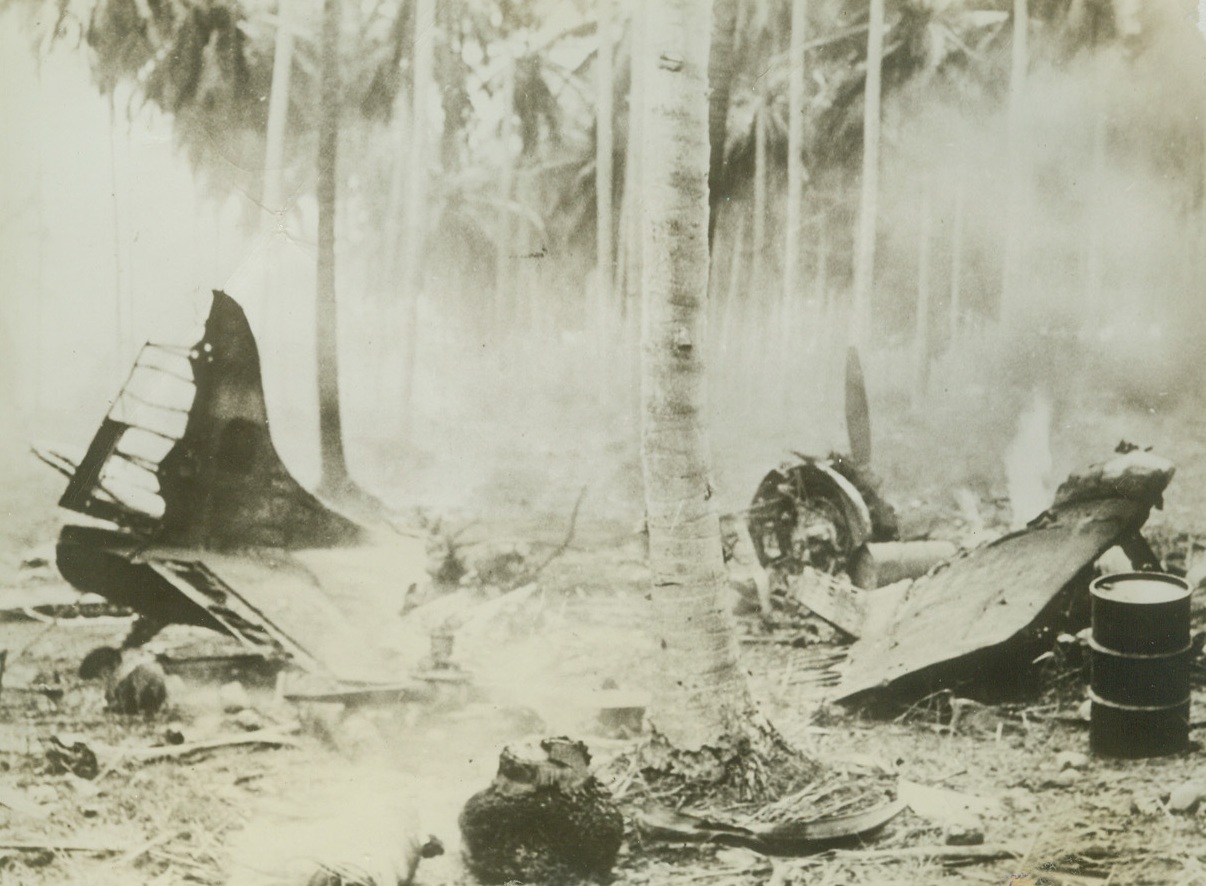
No Title. 11/2/1942.
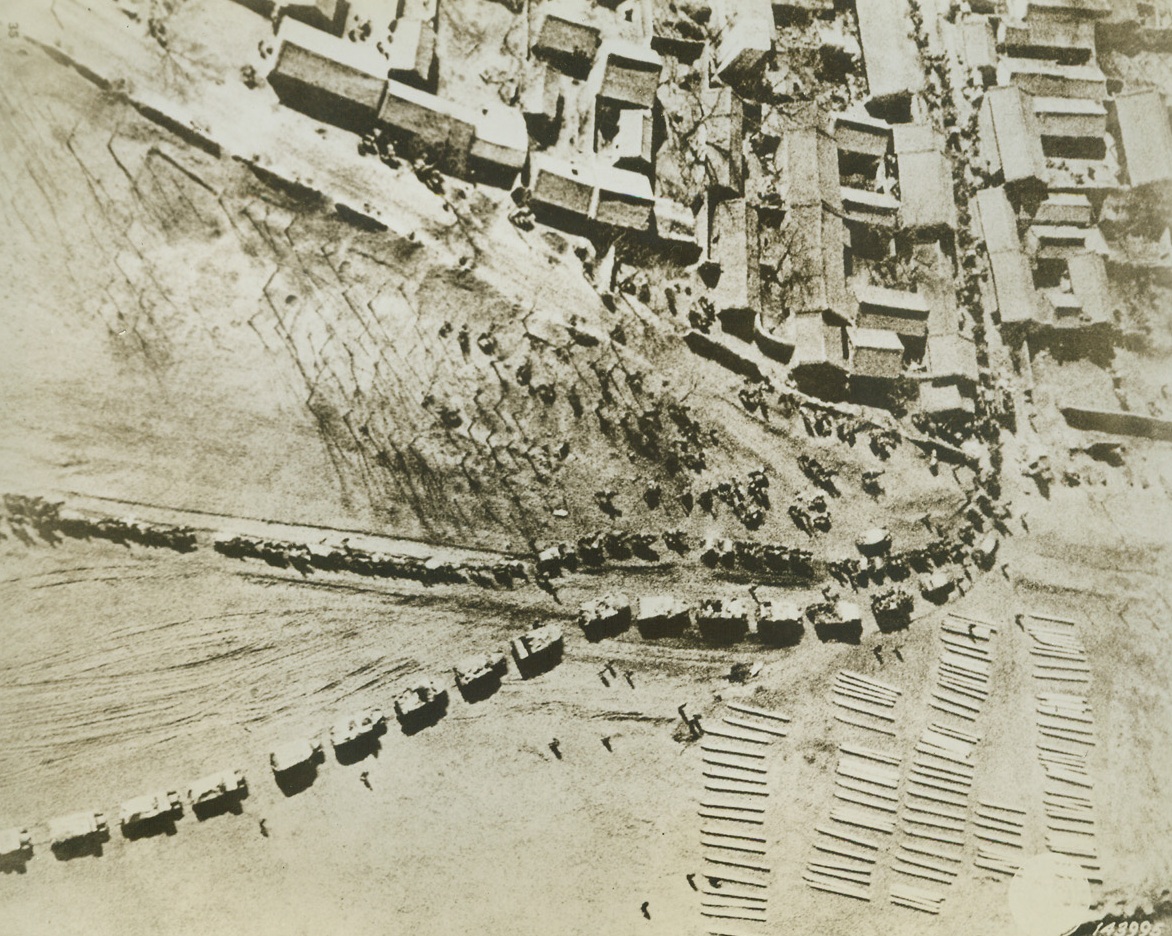
Japs in China Have Transportation Troubles, 11/19/1942. Lacking adequate transportation facilities to get their men, guns, ammunition and supplies to fighting areas, the Japs in China have commandeered everything from horse-drawn carts to wheelbarrows for transportation purposes. This photo, obtained from an unraveled source, is an aerial view of a Japanese troop movement. Credit line (U.S. Signal Corps photo from ACME);
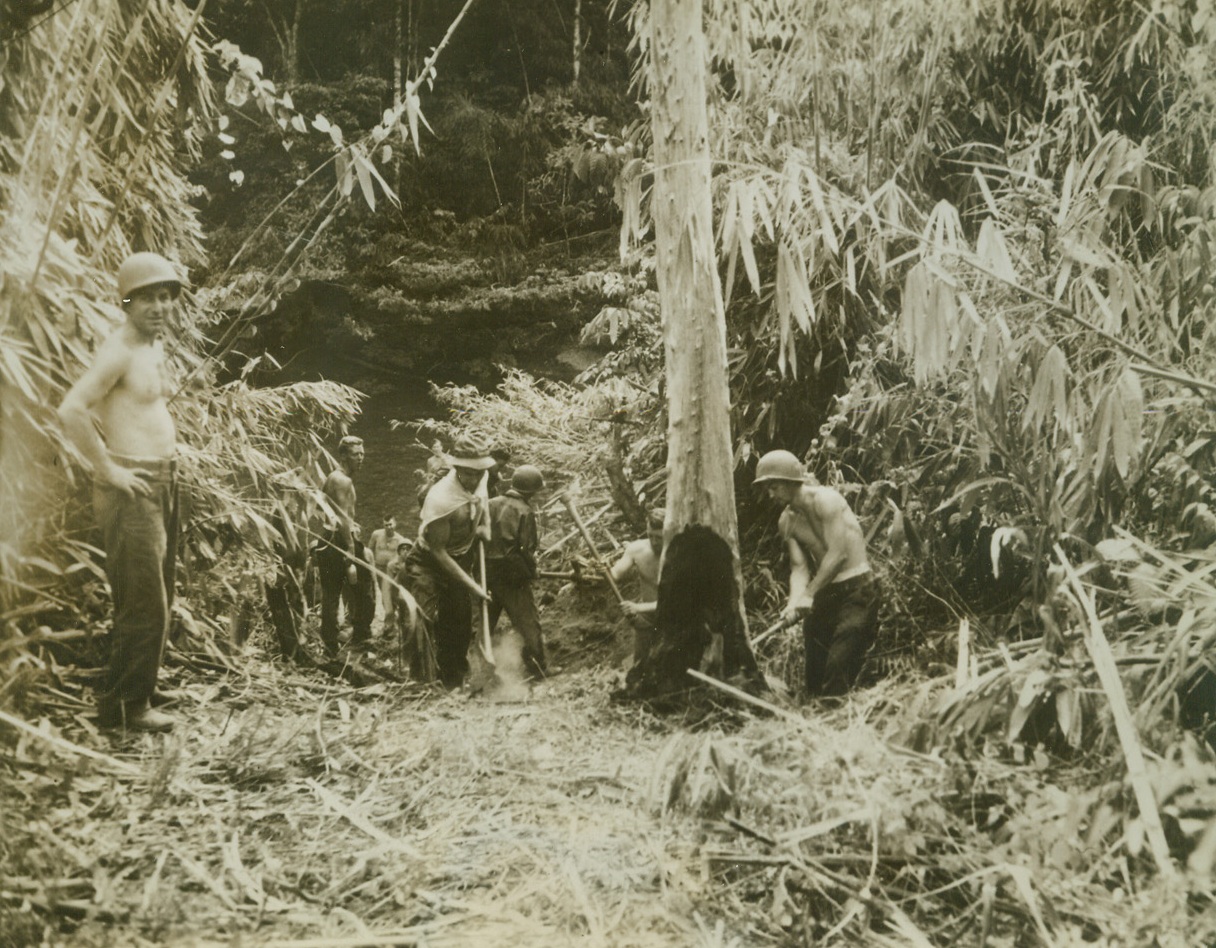
Cutting a Jeep Road, 11/12/1942. New Guinea – Getting supplies to troops in the Owen Stanley mountain range in New Guinea is one of the major problems of U.S. Troops in that area. Long before the arrival of Army engineers, regular infantry troops built their own roads with ax and shovel. Here a troop cuts a jeep road through the jungle. Credit line (ACME);
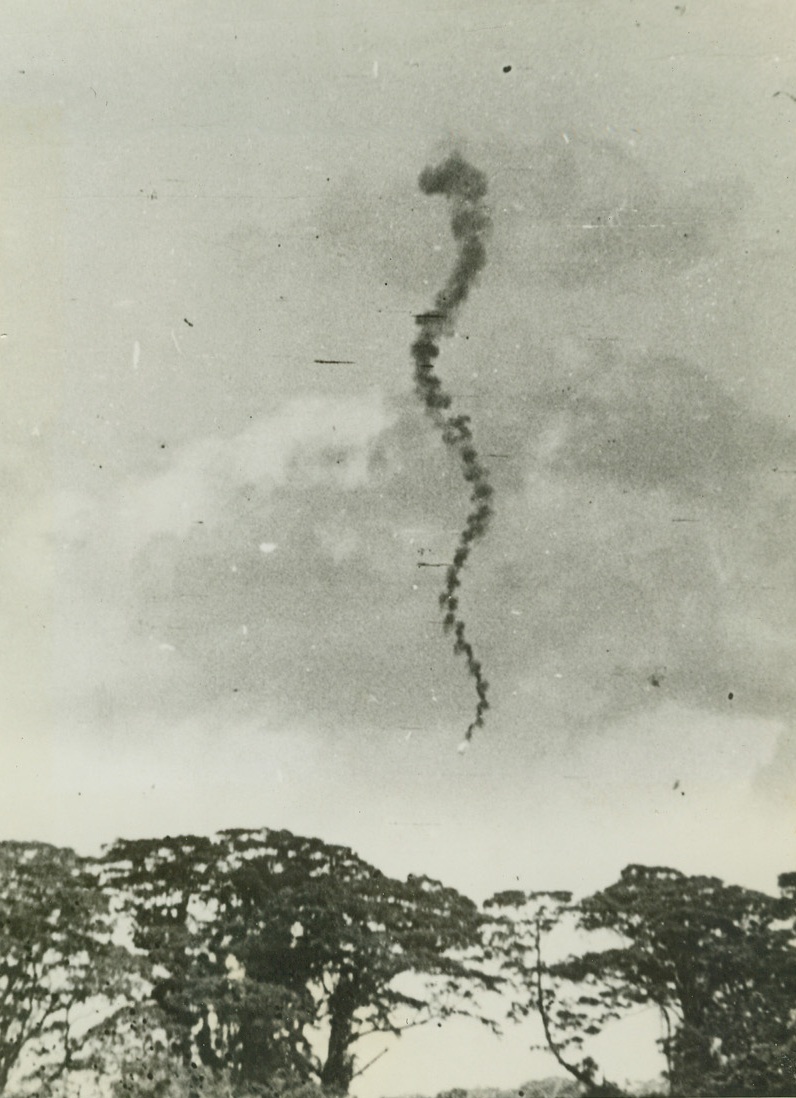
Jap Bomber Takes Death Dive, 11/11/1942. Guadalcanal: - A spiral of smoke trails a Jap bomber to the ground over Guadalcanal in the Solomon islands, after a raid which resulted in disaster for the attackers. Lt. Gen. Thomas Holcomb, Marine Corps commandant who returned from an inspection trip of the Pacific battleground, announced American forces defending Guadalcanal outnumber the enemy on the island. Credit line (ACME);
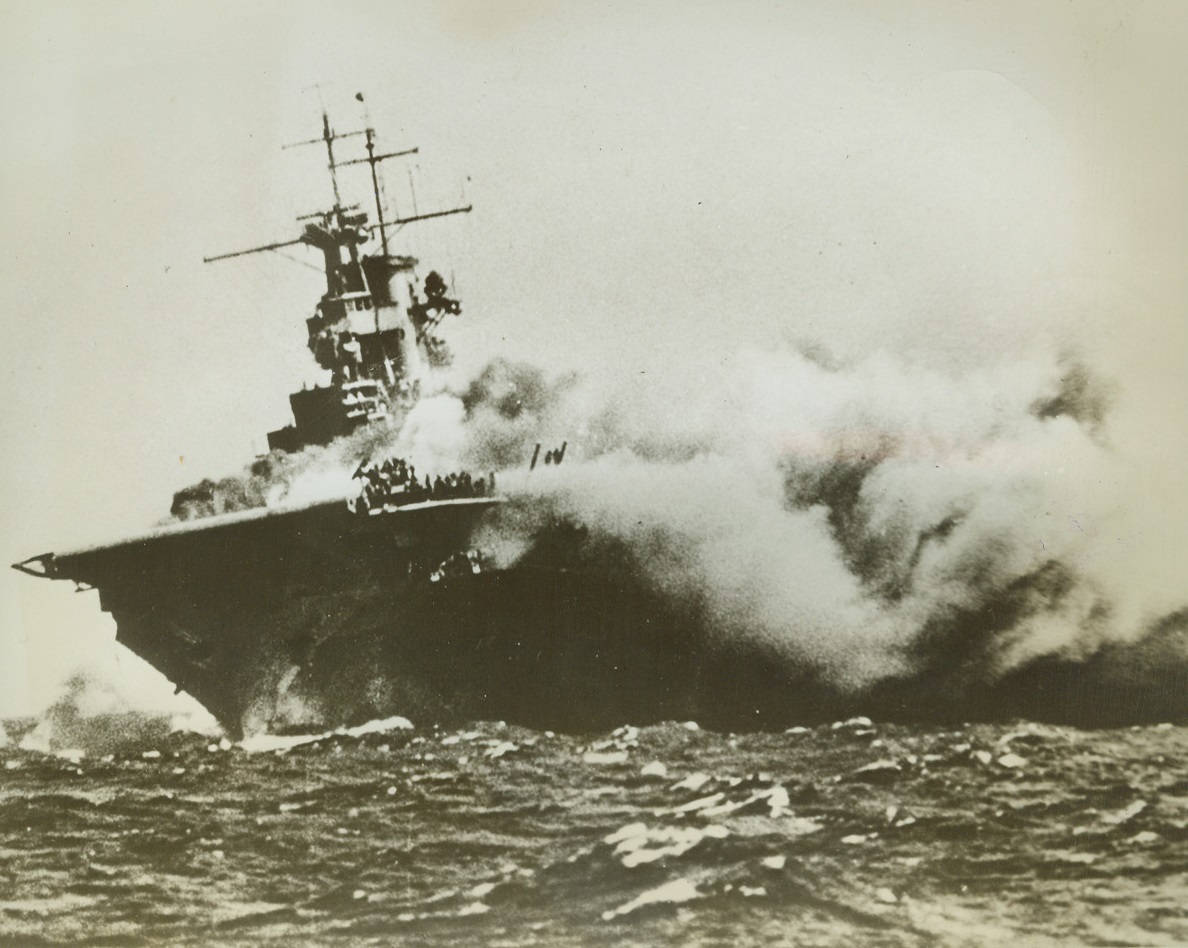
Wasp Crew Taking Refuge, 11/10/1942. This official U.S. Navy photo shows only a few members of the crew that remain on board on the forward flight deck. They take refuge from the sweeping flames. The 14,700-ton carrier was on escort duty near the Solomon Islands at the time she was attacked and sunk. Credit line (off. Navy photo from ACME);
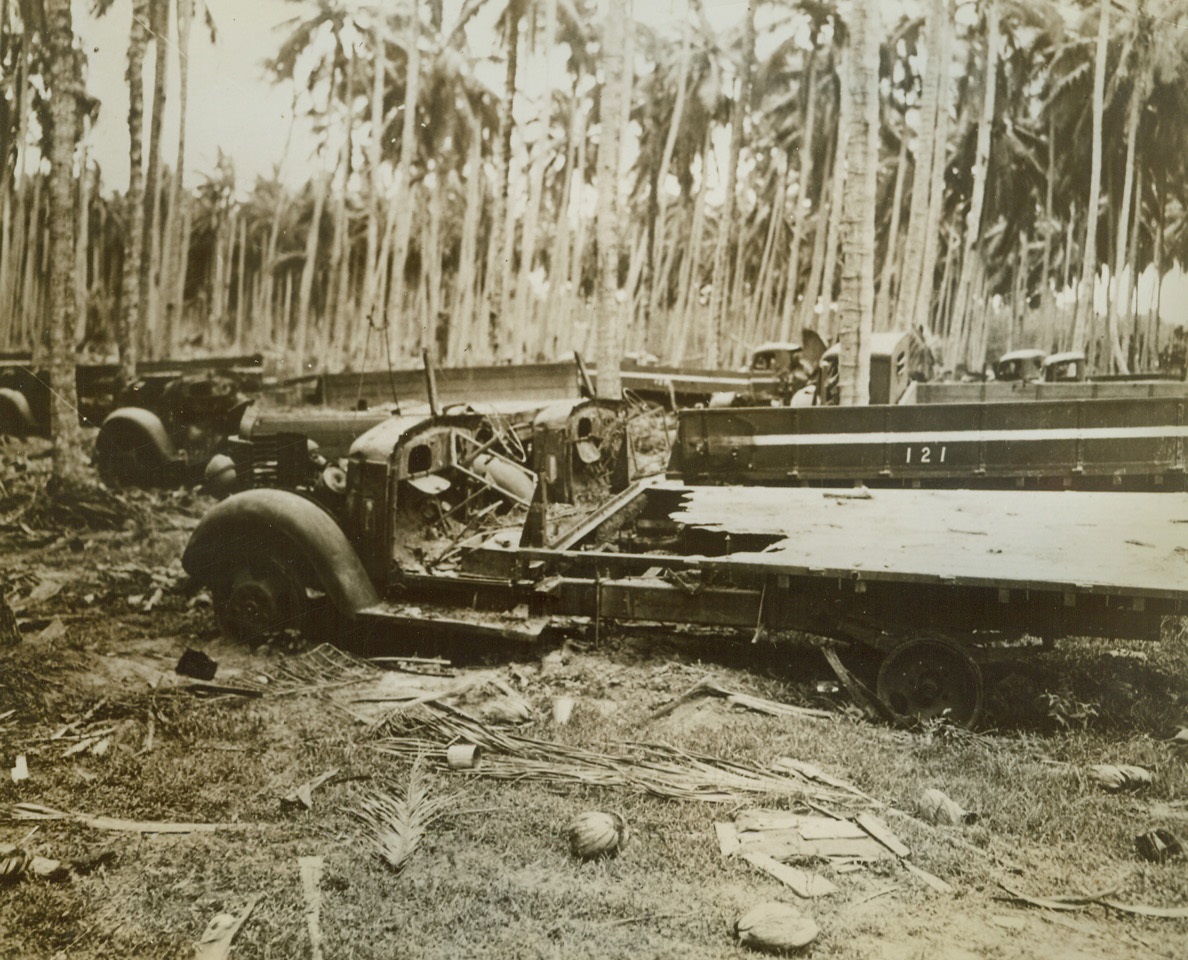
Stopped ‘Em Rolling, 11/7/1942. Guadalcanal – Accurate naval gunnery from U.S. ships lying off Guadalcanal shattered these Jap trucks during the early stages of the battle of the Solomons. The truck in the foreground appear to have suffered a direct hit. Credit line (US Marine Corps photo from ACME);
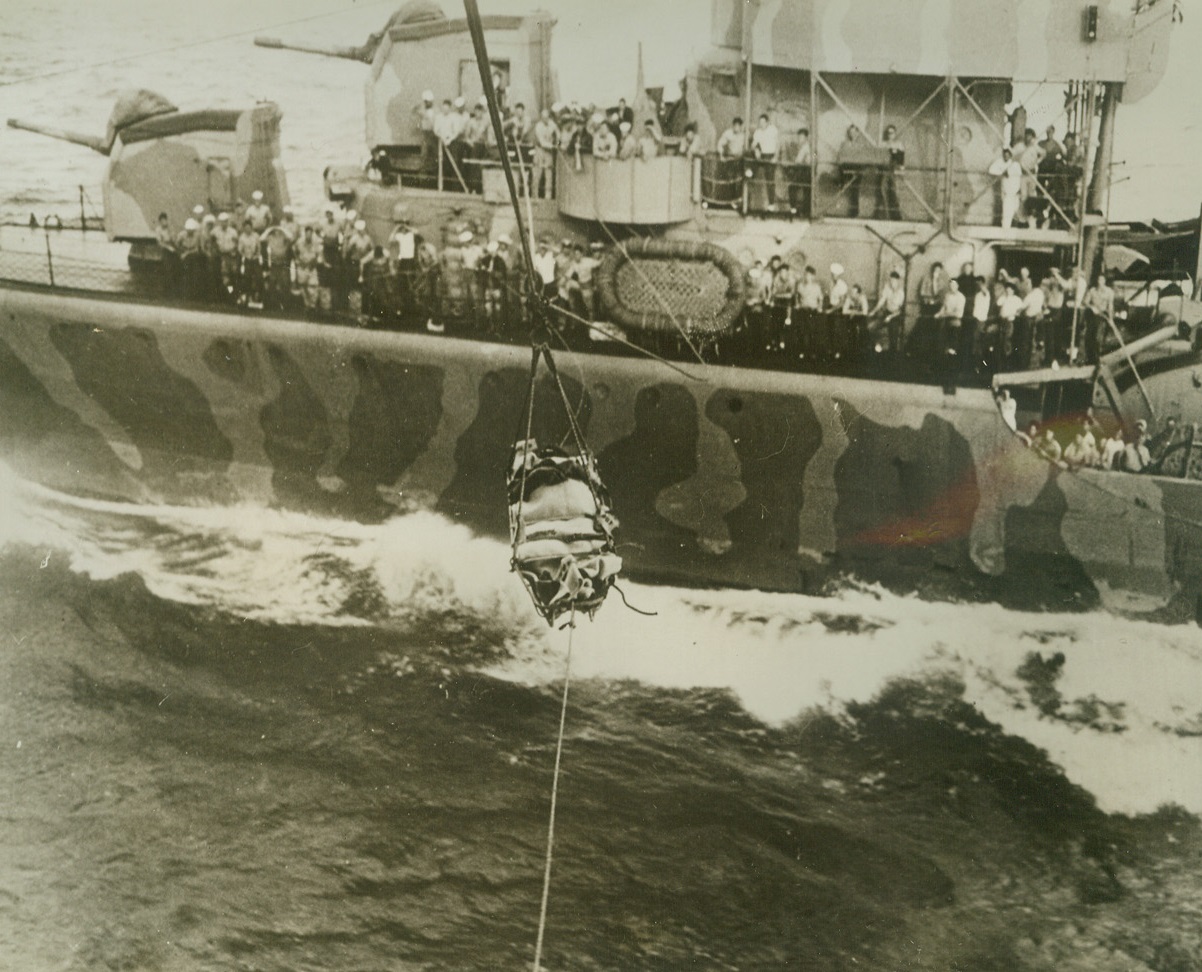
Transfer At Sea, 11/10/1942. Somewhere in the Pacific – Securely strapped in a metal basket, Sgt. R.P. Anderson, U.S. Army Airman, is transferred from a U.S. destroyer, (background), to an aircraft carrier for hospital treatment. Anderson, member of a flying fortress crew, and six companions were rescued by the destroyer after spending seven days on a raft in the Pacific, following a crash landing. Credit line (U.S. Navy official photo);
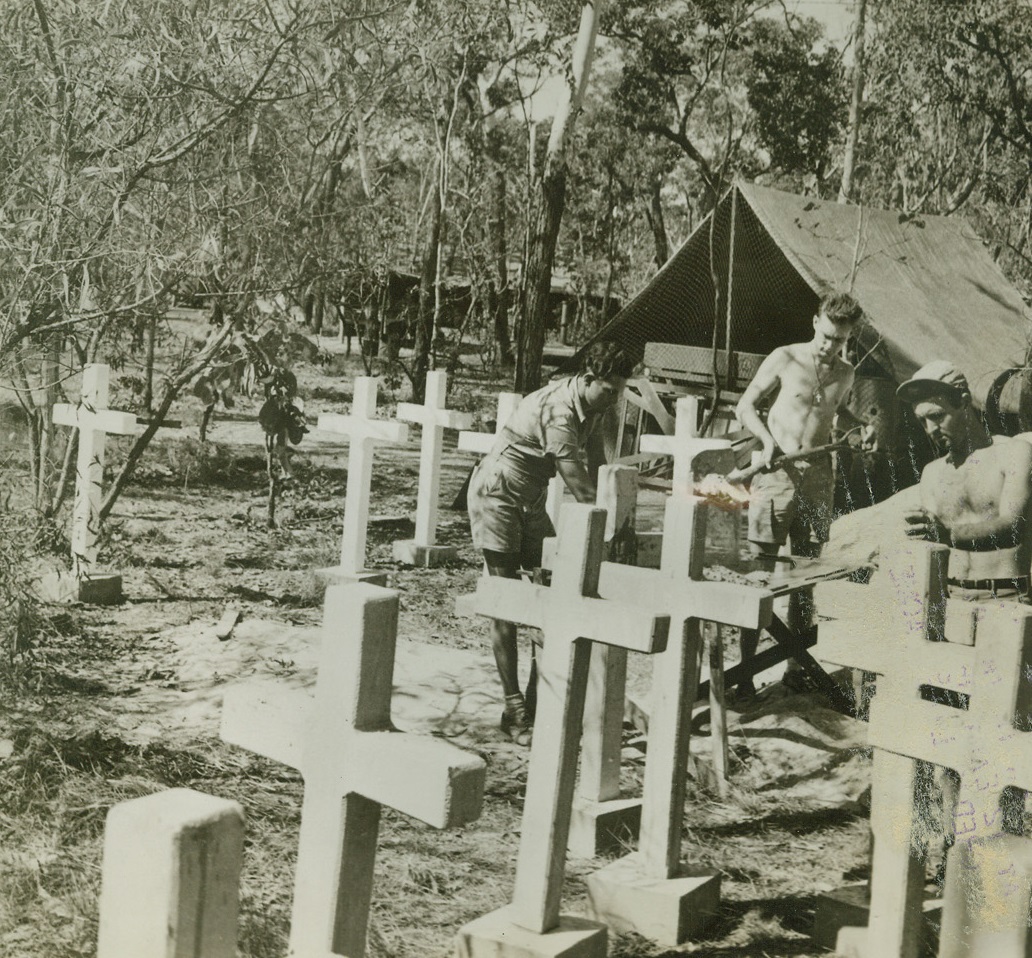
American Graveyard Near Darwin, 11/3/1942. Darwin, Australia – In the heart of the jungle near Darwin, Australia, soldiers mix cement for the crosses to mark graves of U.S. Airmen who died in battle. Wooden crosses didn’t last long over the final resting places of the fighting pilots who were killed in air combat with Jap raiders. Credit line (ACME);
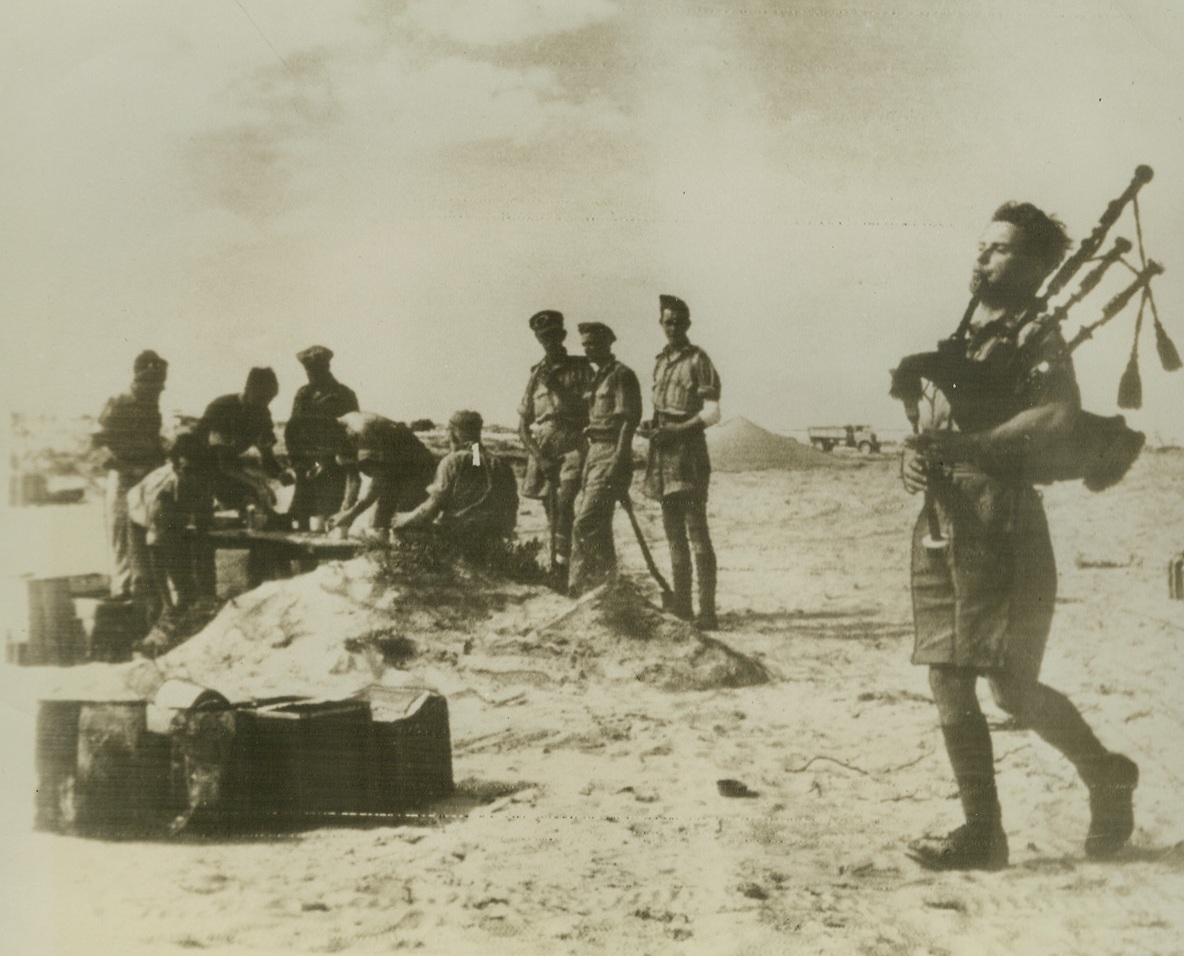
Bagpipes Sound the Call to Arms, 11/1/1942. North Africa – Instead of the traditional fanfare of trumpets, the music of bagpipes leads men of the highland division in attacks in the Western desert. The piper at the right and others like him have distinguished themselves in leading their division in the last few days.Credit line (ACME radio photo);
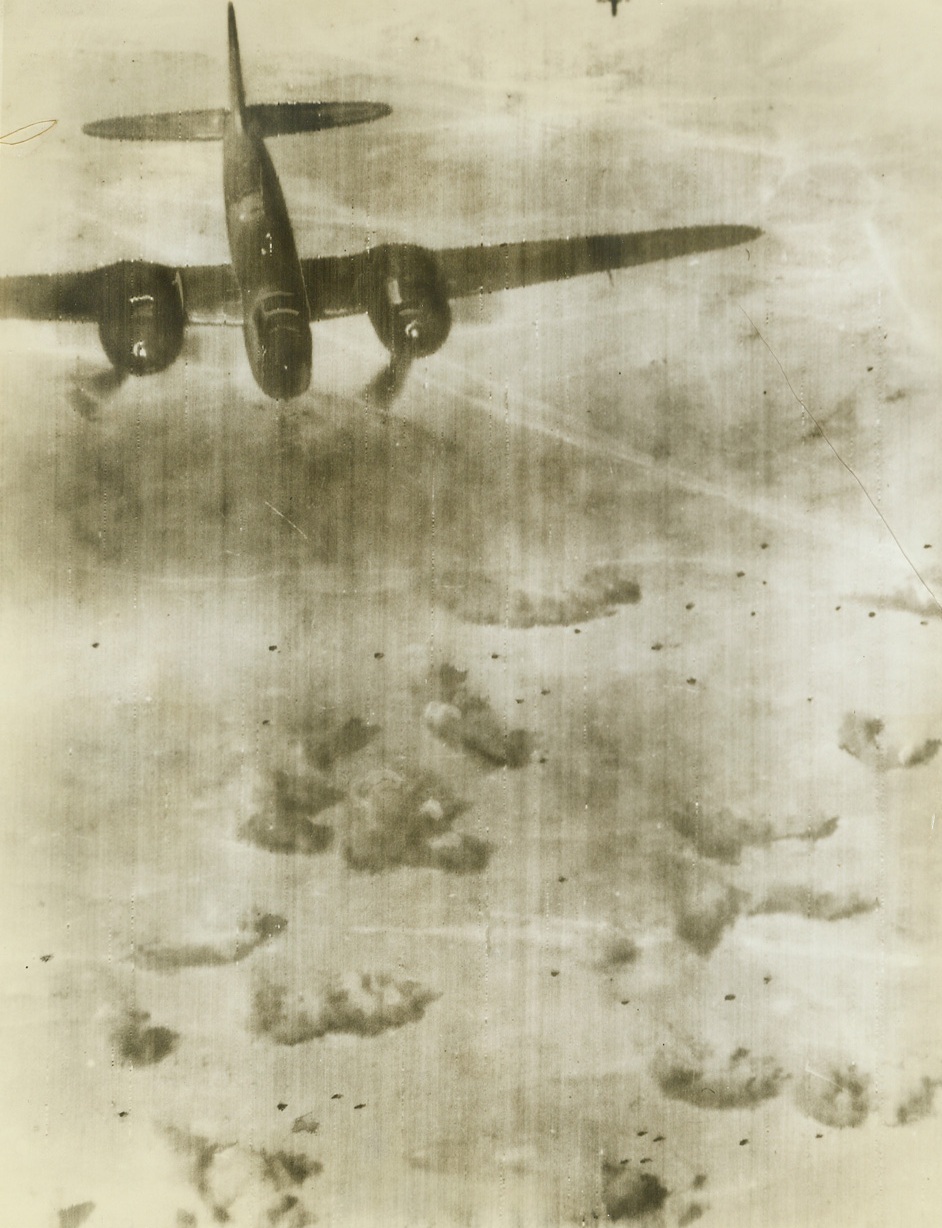
Laying Eggs, 11/6/1942. Cairo, Egypt – RAF Baltimores rained destruction on fleeing axis troops in the Western desert. Photo radioed from Cairo shows one of the British planes “laying eggs” on retreating German vehicles. Latest reports indicate heavy German losses and continued allied victories on the Egyptian front. Credit line (ACME);
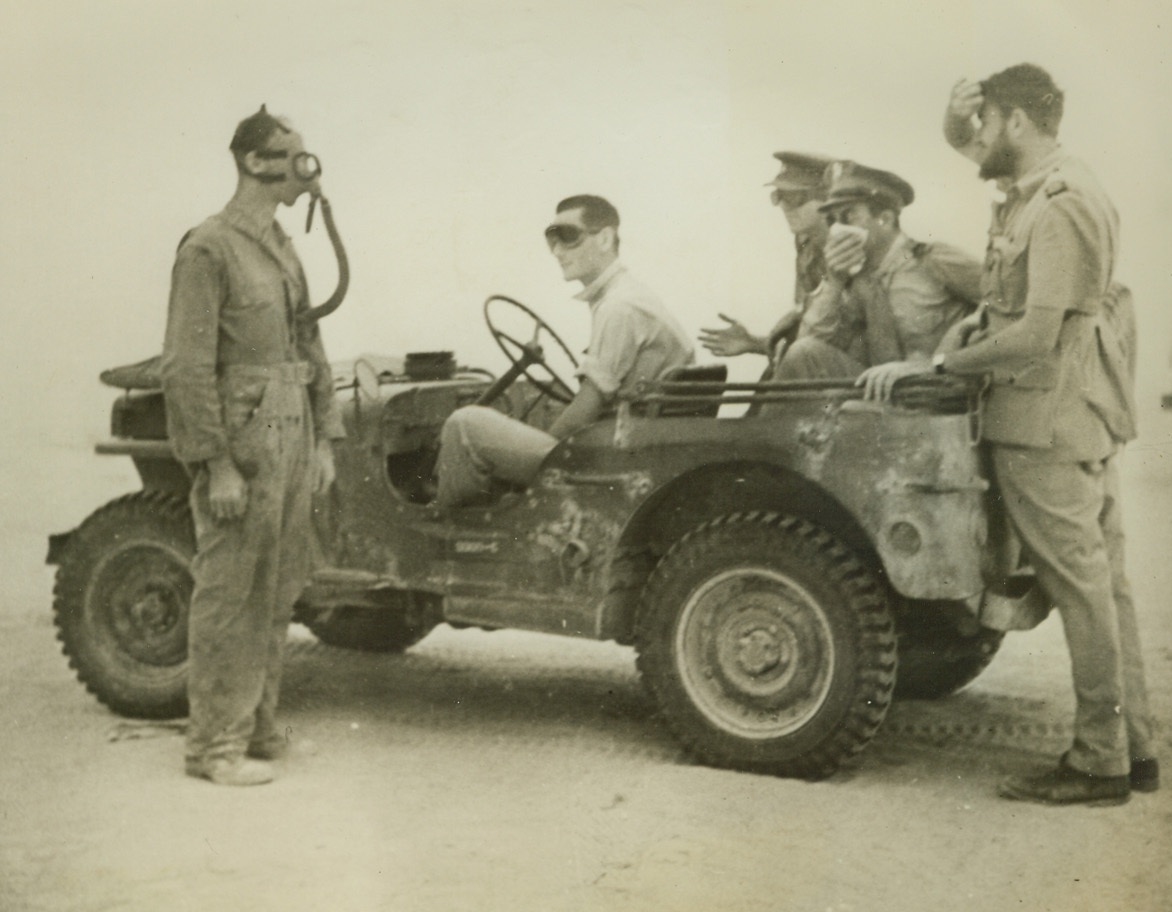
Americans Get Taste of Egyptian Sandstorm, 11/9/1942. On the Egyptian Front—An American war correspondent, Weston Haynes (right), stands behind a peep-load of American Air Forces fighting men, as the group begins to feel the full fury of a desert sandstorm. A mask, pad of cloth and goggles are used to keep stinging sand out of nose, eyes and throat. (Passed by censors).Credit: ACME.;
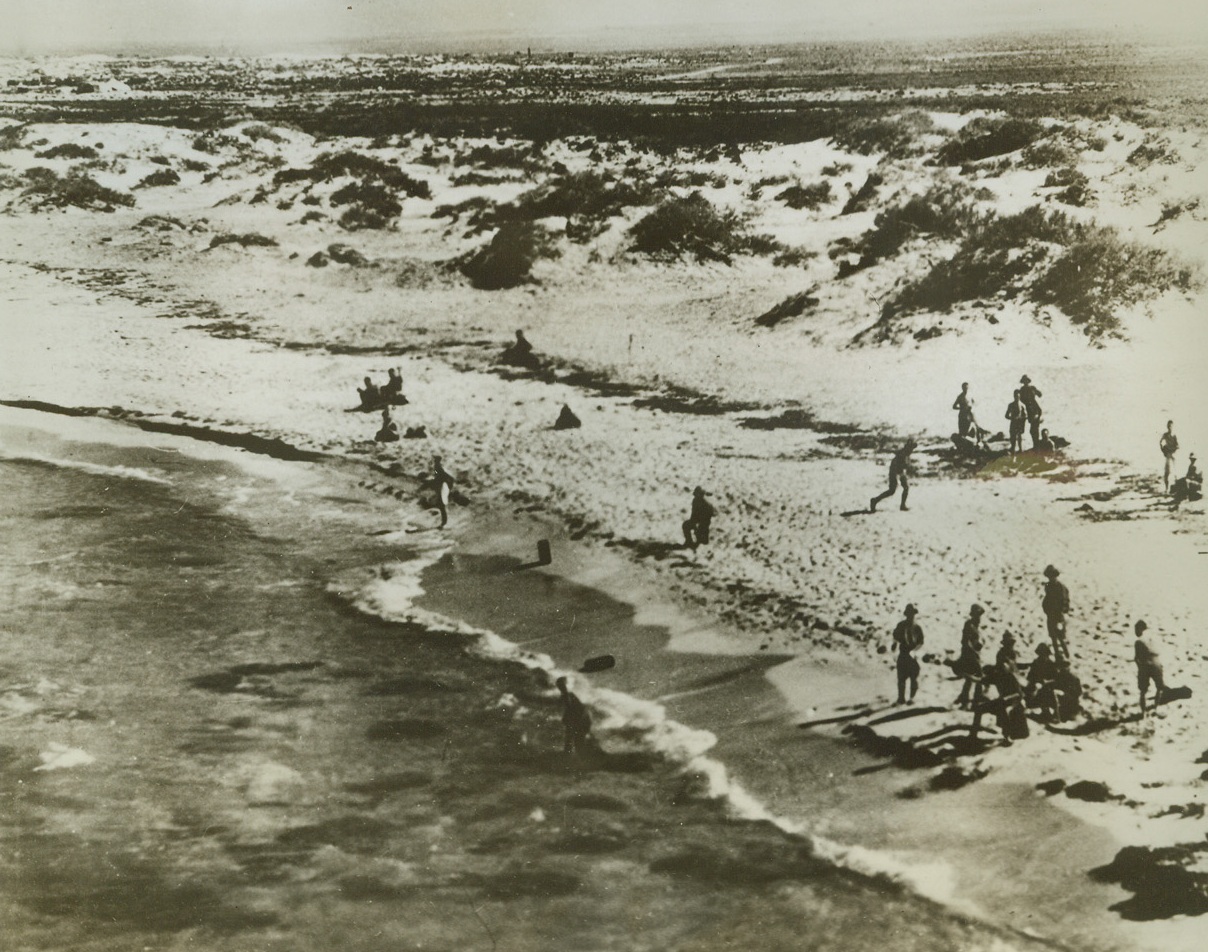
Axis Bathers Surprised by RAF, 11/10/1942. Libya—Axis troops bathing and washing their clothes at Gazala, on the western shore of the bay of Bomba, were surprised by four long-range fighters of the R.A.F. who shot up a nearby parade of enemy troops, killing approximately fifty. The same British fighters successfully attacked five enemy aircraft and four other Cant 506’s at the Libyan seaplane base in Bomba Bay, near Derna.Credit: ACME;
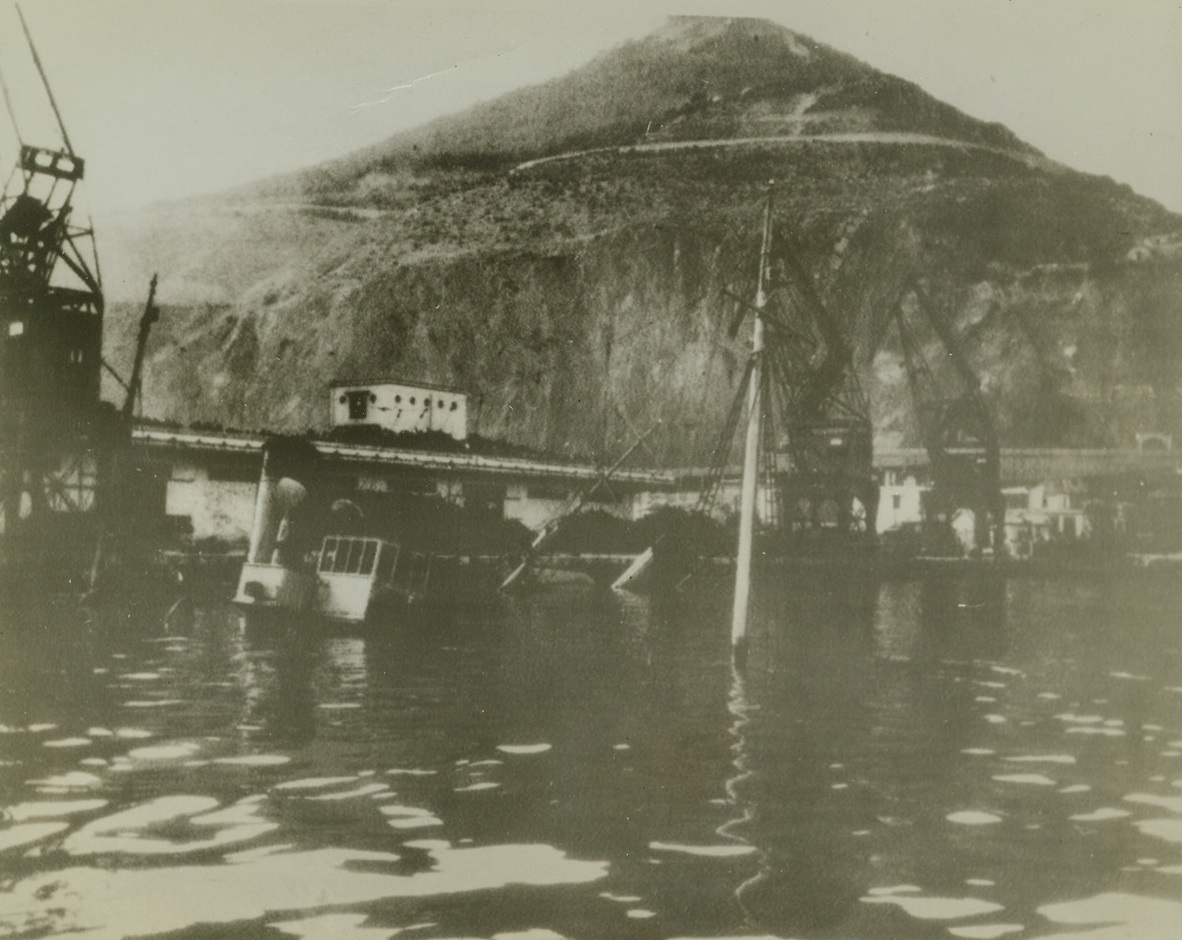
Price Paid, 11/28/1942. Oran, Algeria—With only their masts and funnels showing over the waters of Oran Harbor, these two sunken French ships are part of the price paid by the French when they attempted to bottleneck Oran Harbor before the fall of North Africa to the A.E.F. Six ships were scuttled here and fourteen more were destroyed further inside the harbor. Photo was radioed from London today. Passed by censor. Credit: ACME.;
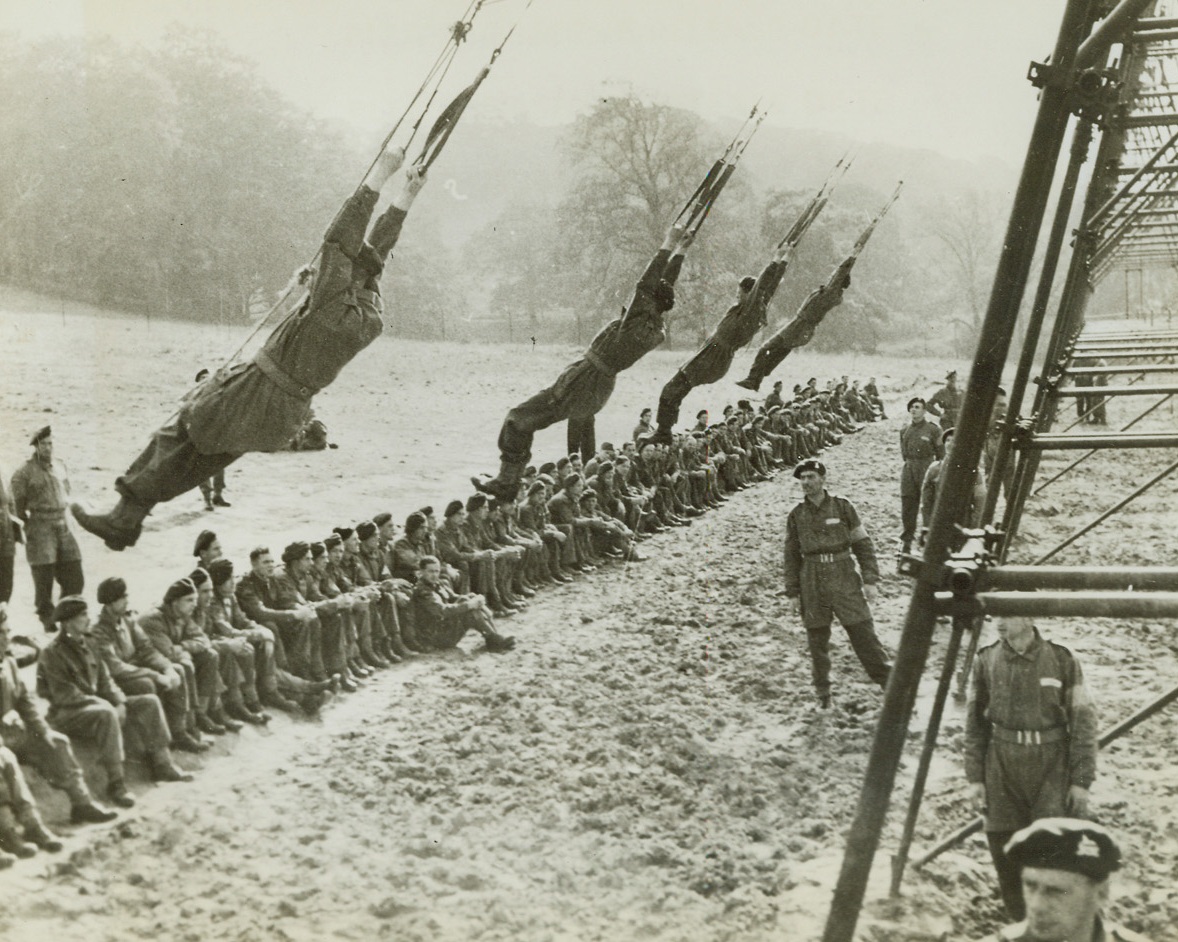
Paratroops Recieve Step-By-Step Training, 11/3/1942. These daring young men on a non-flying trapeze swing high and low and get the feel of the man on the landing end of a hurtling parachute. Other paratroop recruits await their turn on the multiple trapeze that is part of the airborne troops ground training. Credit: ACME.;
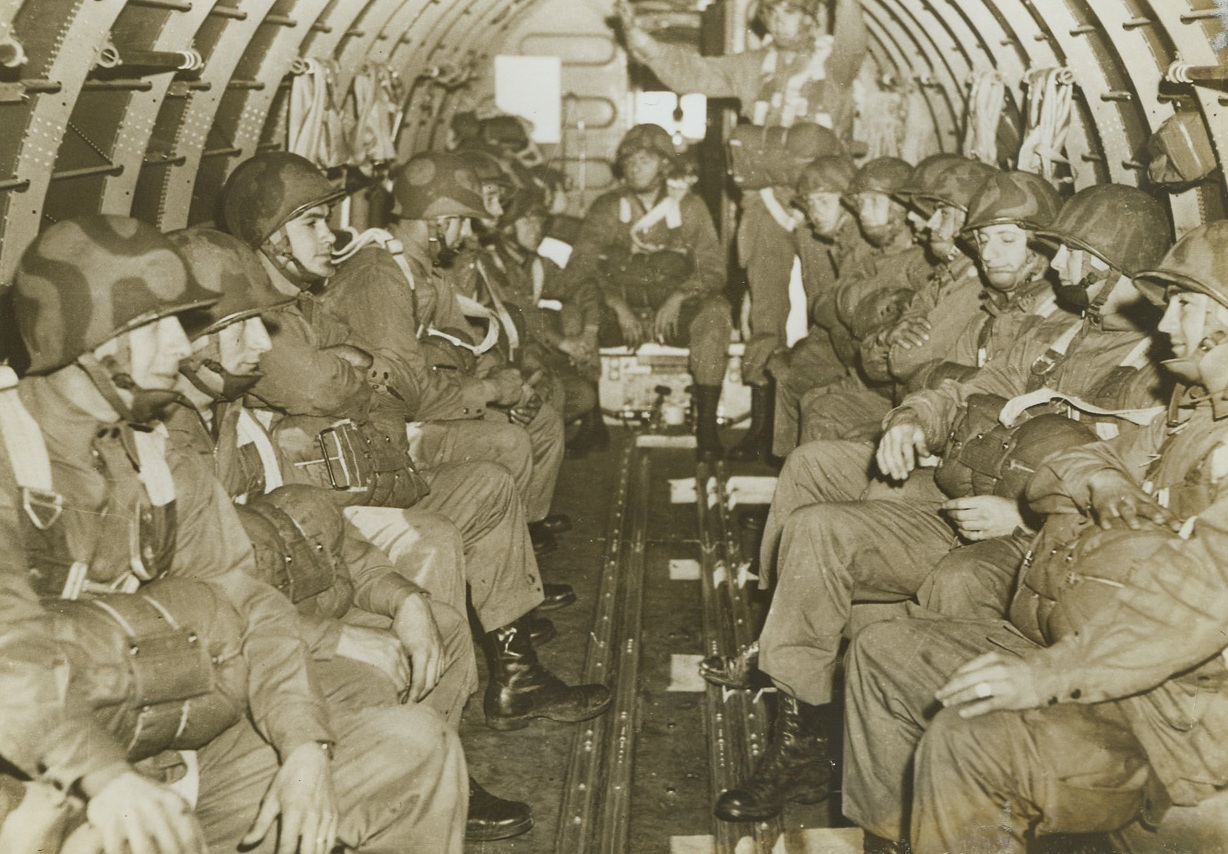
Before They Leap, 11/7/1942. North Ireland—Wearing their parachutes and camouflaged helmets, U.S. Paratroopers sit at ease along the sides of a big troop-carrying plane waiting for their cue to “hit the silk.” Photo was taken during training of American soldiers learning to be expert jumpers. Passed by censors. Credit: ACME.;
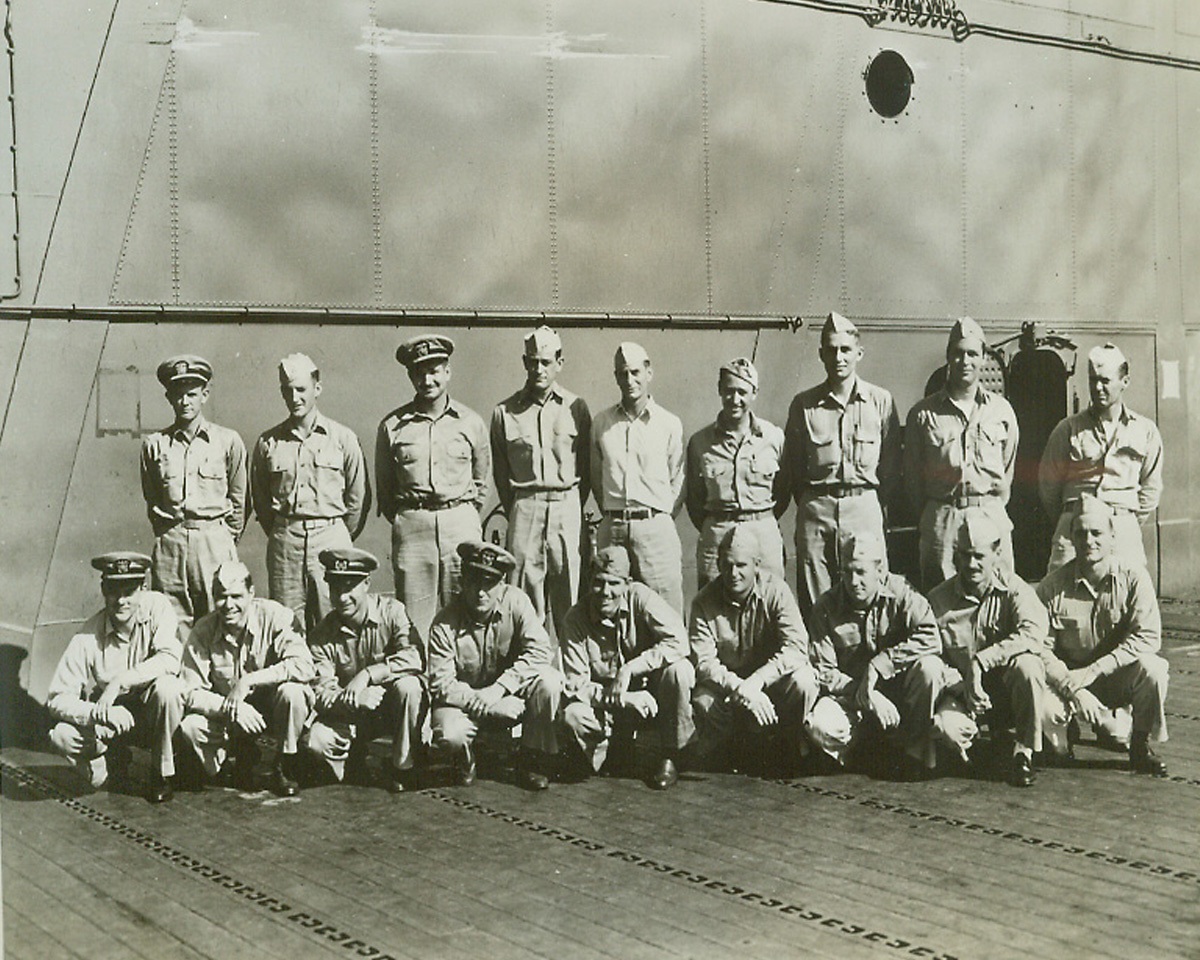
Missing Pilots Honored, 11/10/1942. Nine members of the U.S. Navy Torpedo Squadron shown here and who are now listed as missing, have been awarded the Navy Cross by the Secretary of the Navy for their extraordinary heroism in the action against Japanese forces in the Battle of Midway, according to announcement in Washington. Nov. 10th photo was taken in May, 1942. The nine honored in this group are: (standing) Ensign Randolph Mitchell Holder, (far left); USNR, from Jackson, Miss; Ensign Wiley Brock, (second from left), USN, of Montgomery, Ala; Lt. Paul James Riley (fourth from left), USN, Hot Springs, Ark; Lt. Comdr. Eugene Elbert Lindsey, (fifth from left), USN, Coronado, Calif; Lt. Arthur Vincent Ely (sixth from left), USN, Pittsburgh, PA; and Ensign Louis Rombach, (seventh from left). Front row: Lt. (Jg) Lloyd Thomas Eversole, (seventh from left), USN, Pocatello, Idaho. Credit: U.S. Navy photo from ACME.;
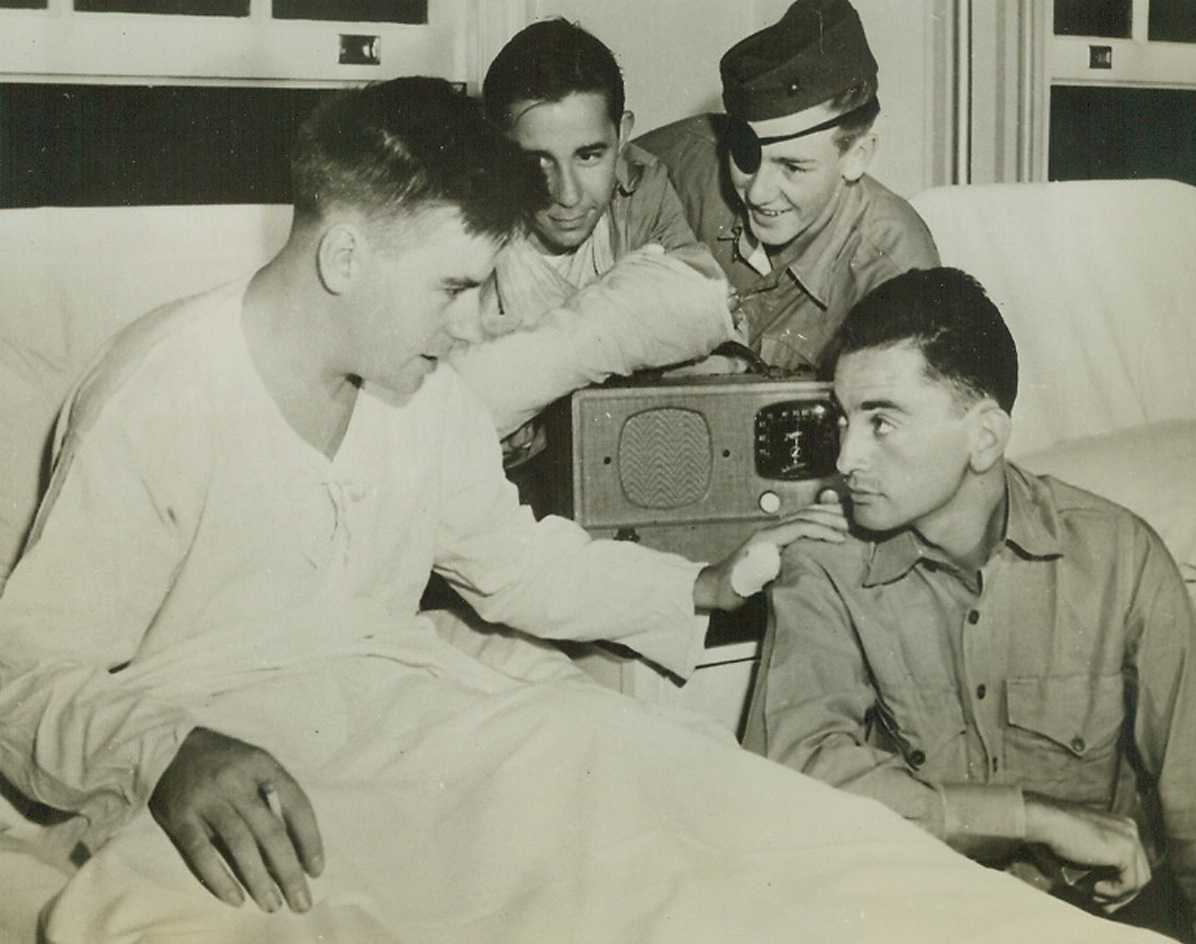
He Mowed Them Down!, 11/10/1942. San Diego, Calif.—Pvt. Albert A. Schmidt (in bed), USMC, from Philadelphia, Pa., was credited by comrades for killing more than 200 Japs with a scorching hot machine gun before an enemy grenade blinded him in the battle of Tenaru River on Guadalcanal Island. Here, Schmidt is shown talking at a San Diego Naval Hospital to Corp. Leroy Diamond (right foreground), of New York City, who fed the machine gun until he was wounded. Pvt. George McNally (rear right), of Evansville, Ind., whose arm is bandaged, and another unidentified Marine, listen to the conversation.Credit: U.S. Marine Corps photo from ACME.;
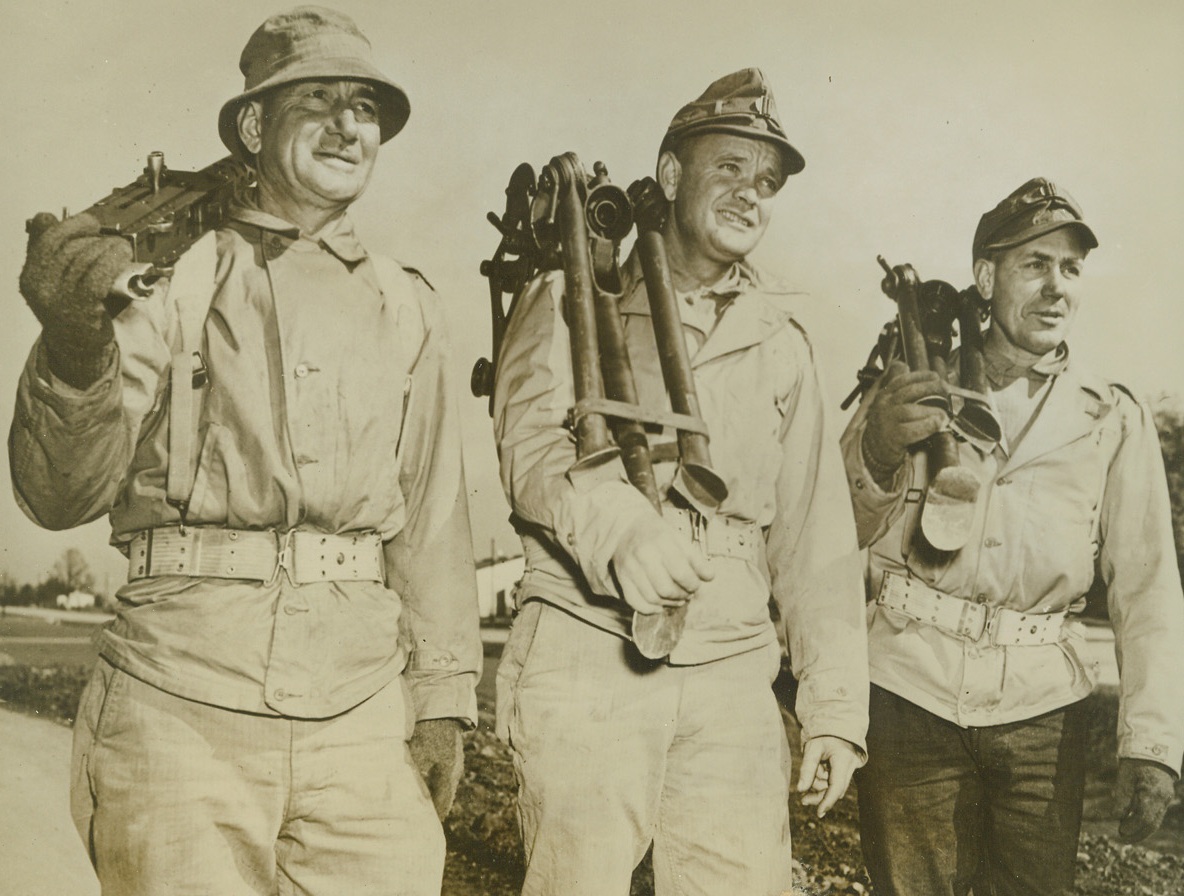
Remember Our Buddies, 11/9/1942. Fort Knox, KY—In the nation’s nerve-center of tank training at Fort Knox, dozens of World War I veterans will pause for a few minutes at 11 o’clock on Armistice Day to pay respects to buddies who gave their lives in the first Great War. Among these soldiers who enlisted for a “second crack at Jerry” are (left to right): Pvt. Joseph E. Peterson, San Antonio, Texas; Pvt. Robert C. Browning, McDermett, Nev., and Pvt. Preston J. Welter, Sr., Marysville, Calif., who was twice wounded during his 15 months at the front in ’18. And they didn’t relish the idea of being called recruits.Credit: ACME.;
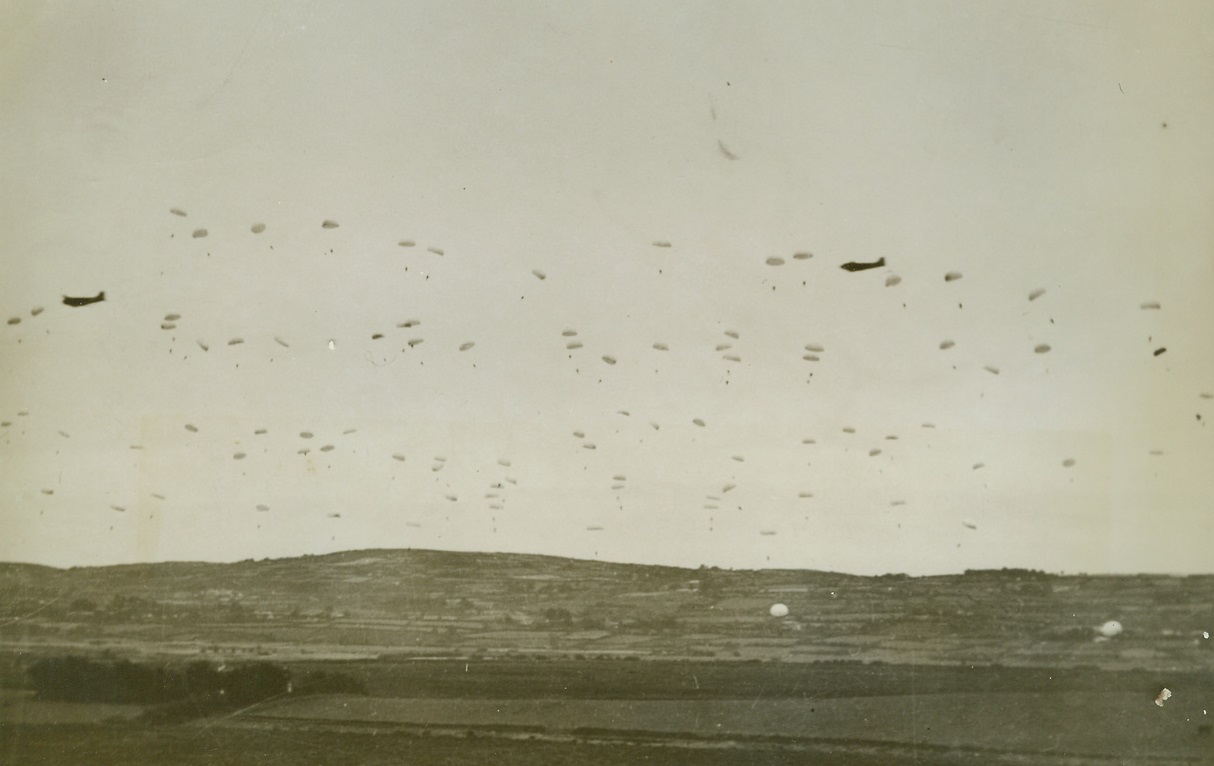
Floating to Earth, 11/7/1942. North Ireland—Hundreds of billowing parachutes float slowly toward the green fields of Ireland. Training to be invaders, these Yanks complete a jump successfully, which brings them one step closer to admittance into the U.S. Patatrooper Force. (Passed by censor) Credit: ACME.;
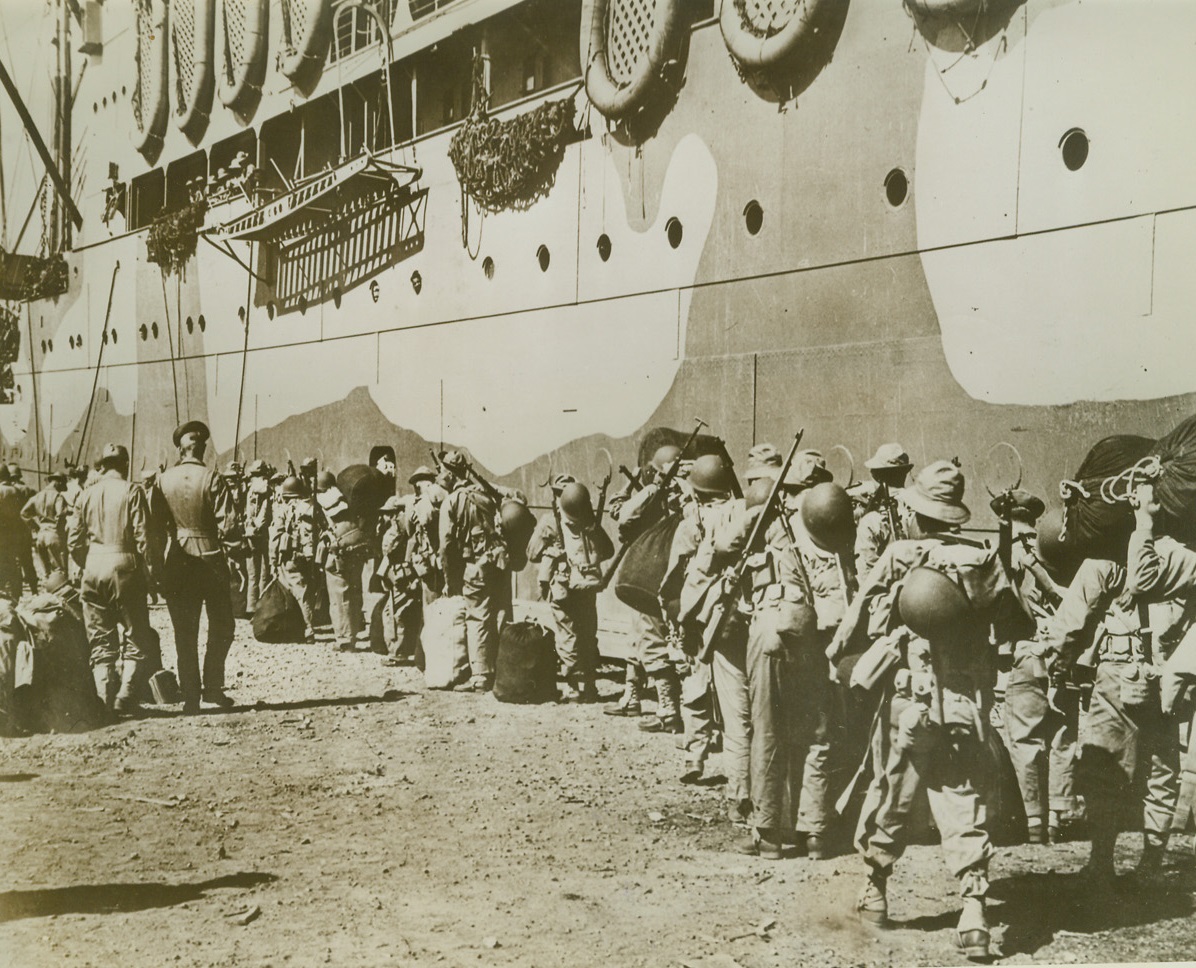
Army Reinforces Marines in Solomons, 11/4/1942. Washington, D.C. -- This photo, just released in Washington, shows a U.S. Army Task Force boarding a transport at New Caledonia, just before it left to reinforce U.S. Marines, who are engaged in bitter fighting with the Japs in the Solomon Island area. Credit: U.S. Army photo from ACME;
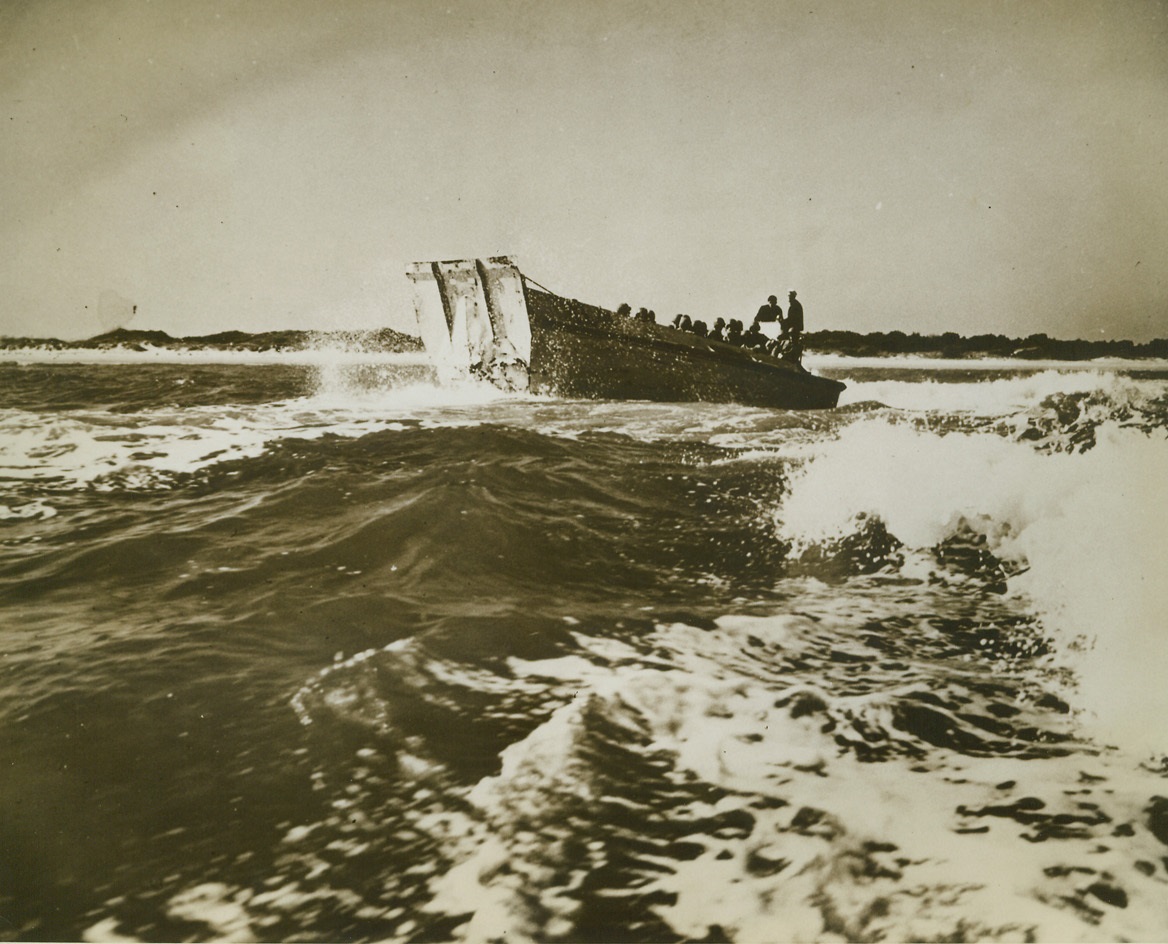
Over the Waves, 11/5/1942. New River, North Carolina -- Riding high on the waves, a Higgins Landing Boat carries armed Marines to the beach for assault action during a part of the intensive training course given at the U.S. Marine base at New River, in the Marine’s Advanced School of Combat Techniques. Passed by censor. Credit: ACME;
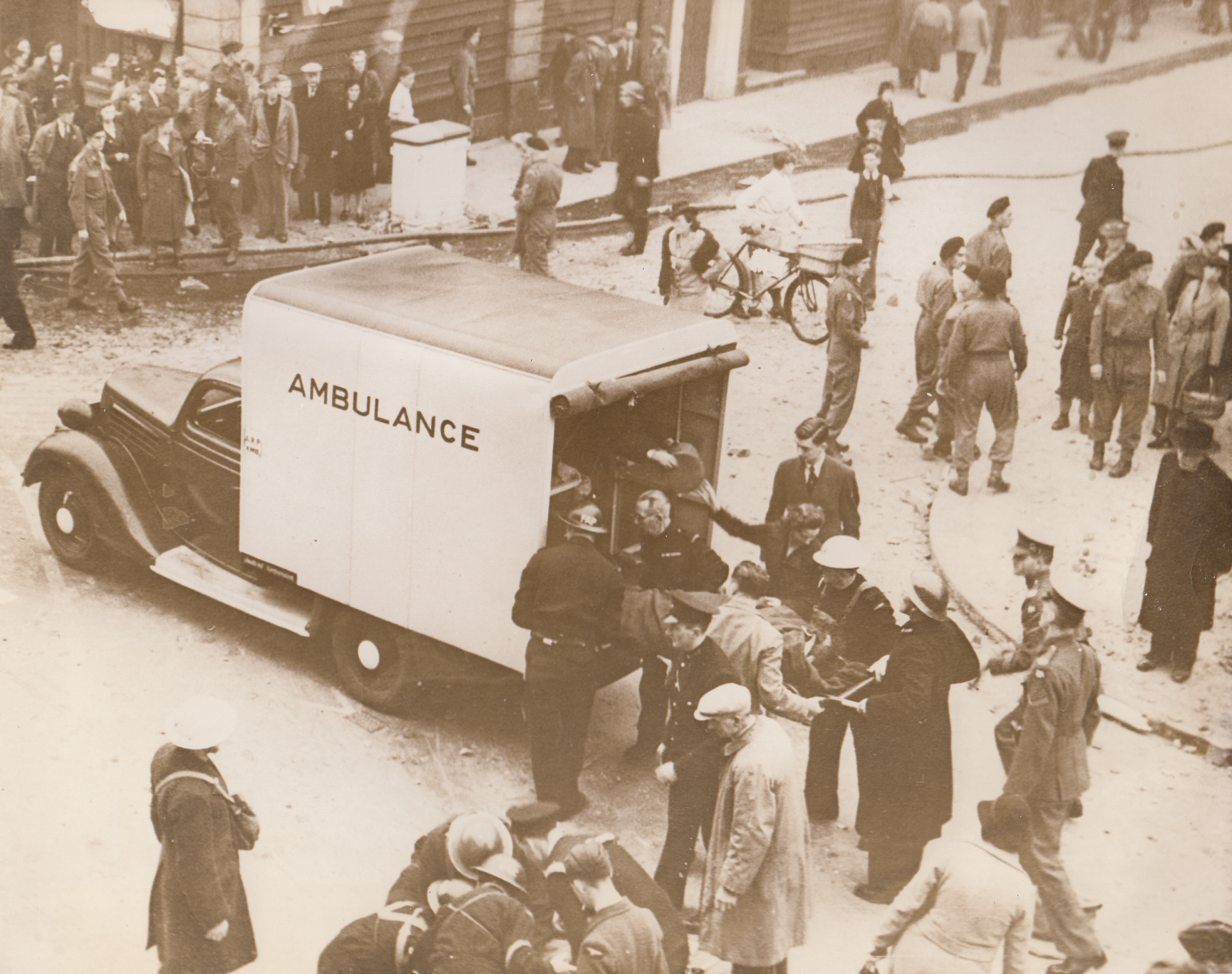
Casualties Being Removed After Raid, 11/4/1942. ENGLAND - Casualties are placed in an ambulance by ARP workers, after a Nazi plane had staged a daylight raid on a town in East Anglia. The plane damaged the office and shopping center of the town with bombs and machine-gunned the streets. Note fire house stretched across street, (upper part of photo).;
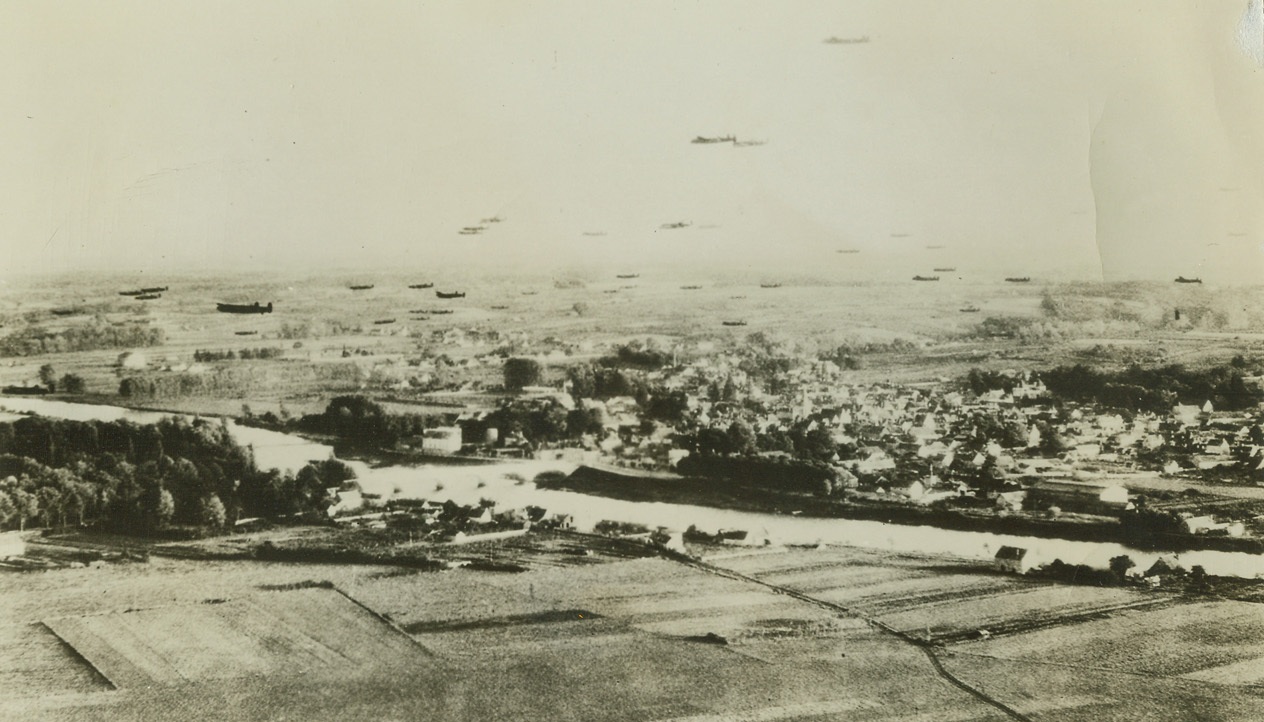
Armada of “Lancasters”, 11/10/1942. This unusual photo shows an armada of huge RAF “Lancaster” four-motored bombers as they roared over the village of Mon Richard in France, on their way to blast the Schneider Works at Le Creusot, last October 17. Each of the ships carried almost nine tons of bombs and flew at less than 300 feet to cause tremendous damage to the motor works, which was building equipment for Nazi tanks and planes. Passed by censors. Credit: ACME;
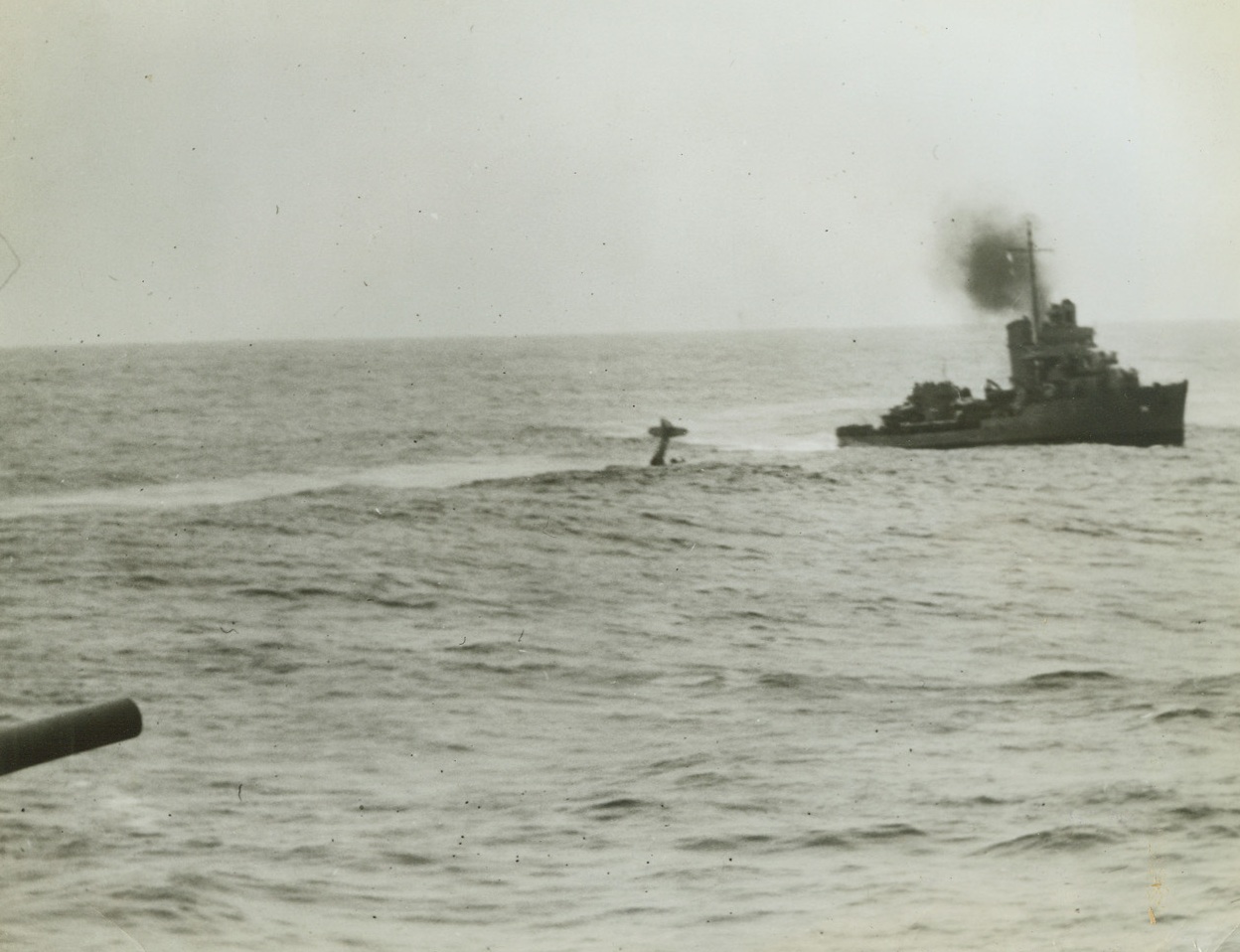
Flyers Take Dunking, 11/4/1942. A destroyer maneuvers to rescue the crew of a U.S. Navy plane which missed its landing on the carrier belonging to gun at extreme left. The airmen are barely discernible at right of plane. Credit: Official U.S. Navy photo from Acme;
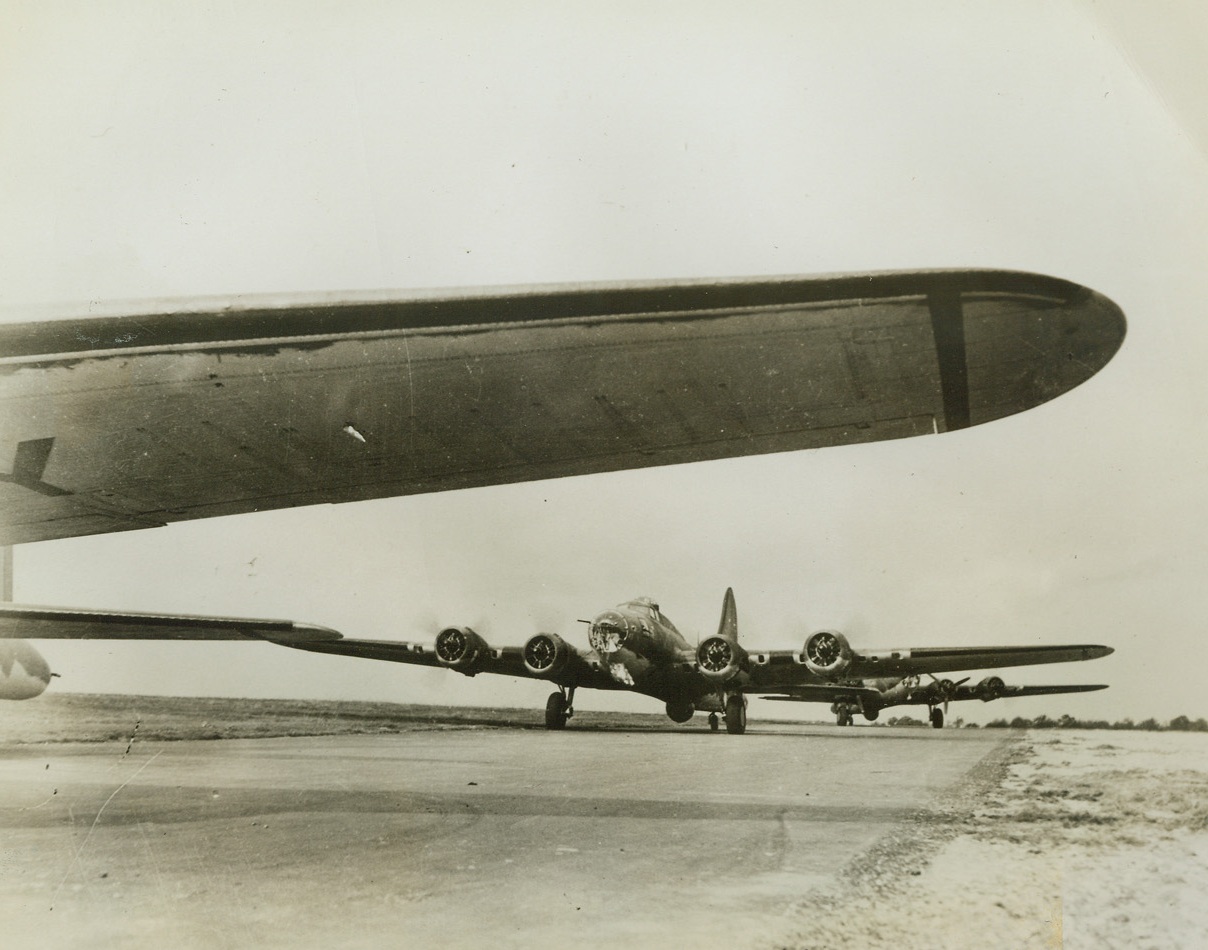
Roaring Off to Raid, 11/3/1942. England – While the wing and tail of one passes out of the picture, two of Uncle Sam’s “Flying Fortresses” are “getting up steam” on the runway just before taking off on a bombing mission over Germany or occupied France. The effectiveness of these monsters of America’s air armada is one point in the disputed field of aviation that stands without challenge. Passed by censor. Credit: Acme;
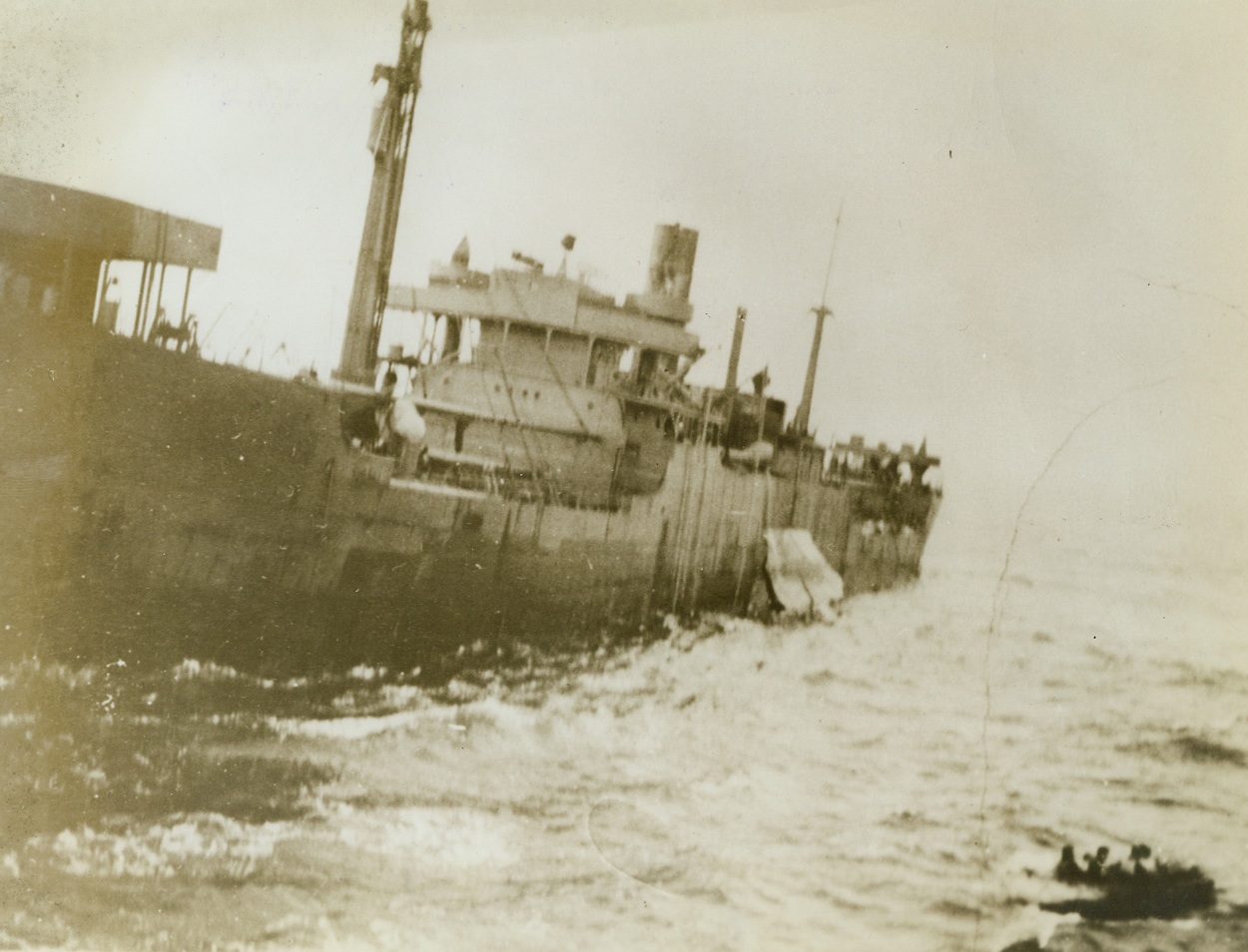
Rescued Crew, 11/12/1942. Somewhere in the Atlantic – Rescued members of the crew of a torpedoed freighter pull their lifeboat toward the United Nations vessel that picked them up. Their freighter remained afloat, menacing other ships, until it was sent to the bottom by depth charges from the rescue ship. Passed by censor. Credit: ACME;
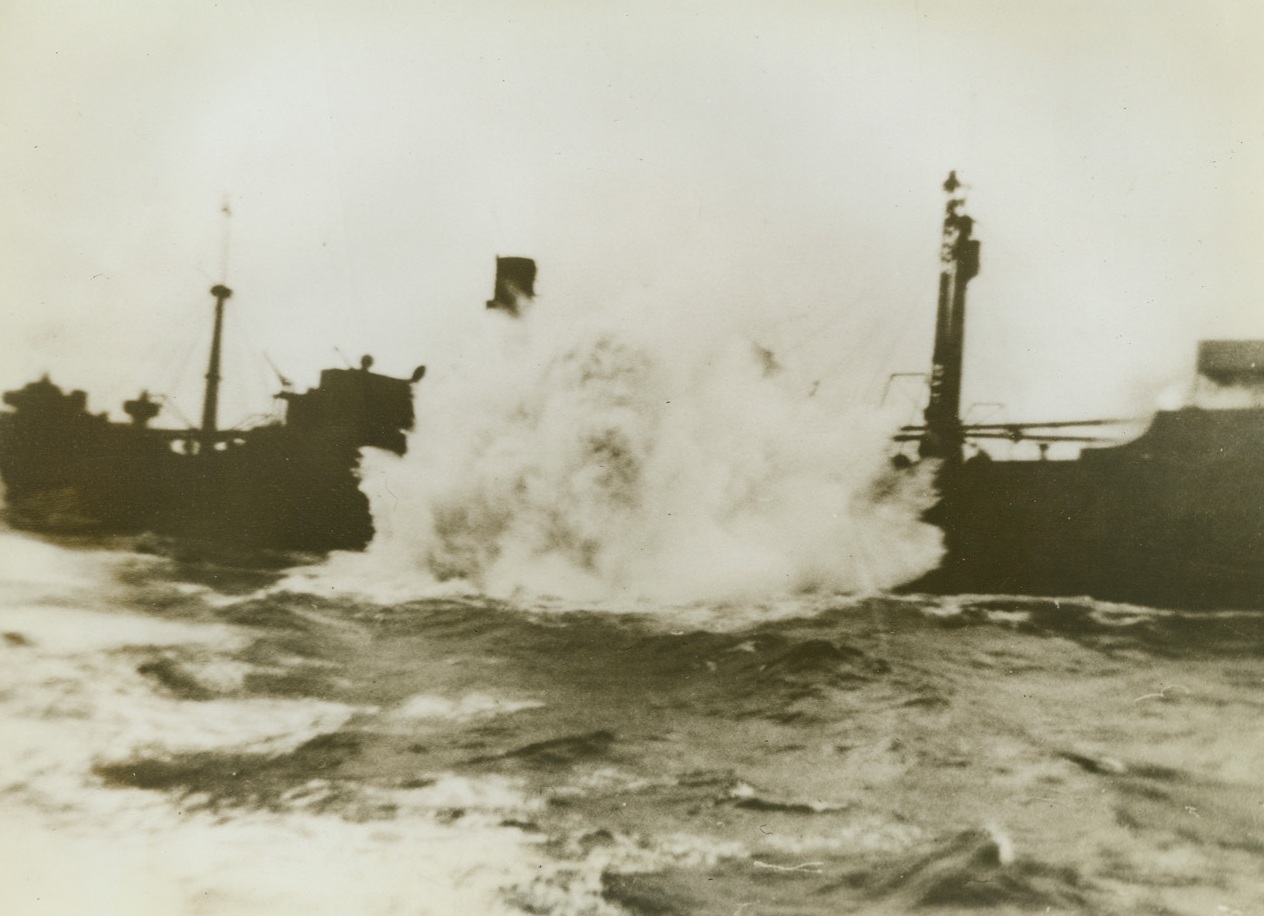
“Mercy Shot”, 11/12/1942. Somewhere in the Atlantic – A milky spray of sea water roars aloft as a depth charge from a United Nations vessel explodes against the hull of a freighter that had been torpedoed in the Atlantic. The ruined vessel was afloat and a menace to shipping, so the United Nations ship rescued its crew and sank the freighter. Passed by censor. Credit: ACME;





 Trash & Recycling
Trash & Recycling
 Online Payments
Online Payments
 City Documents
City Documents
 Parks
Parks
 Traffic Court
Traffic Court
 CITY PARKS
CITY PARKS
 Outdoor Recreation
Outdoor Recreation
 Volunteer
Volunteer
 Home
Home TRANSLATE
TRANSLATE
